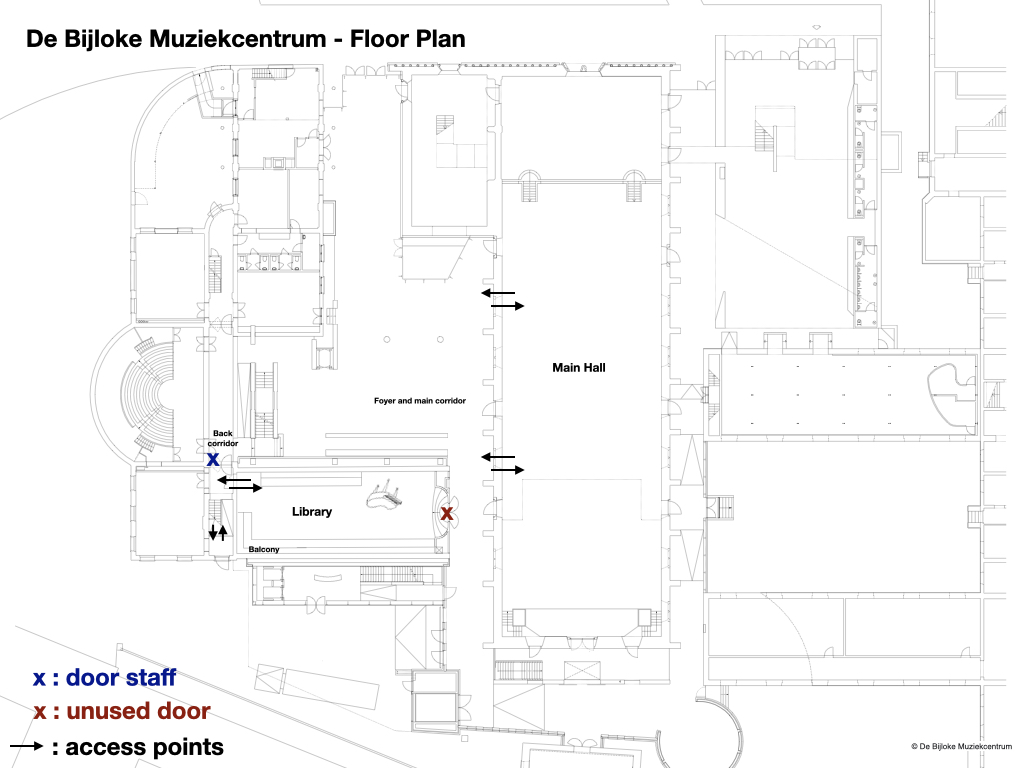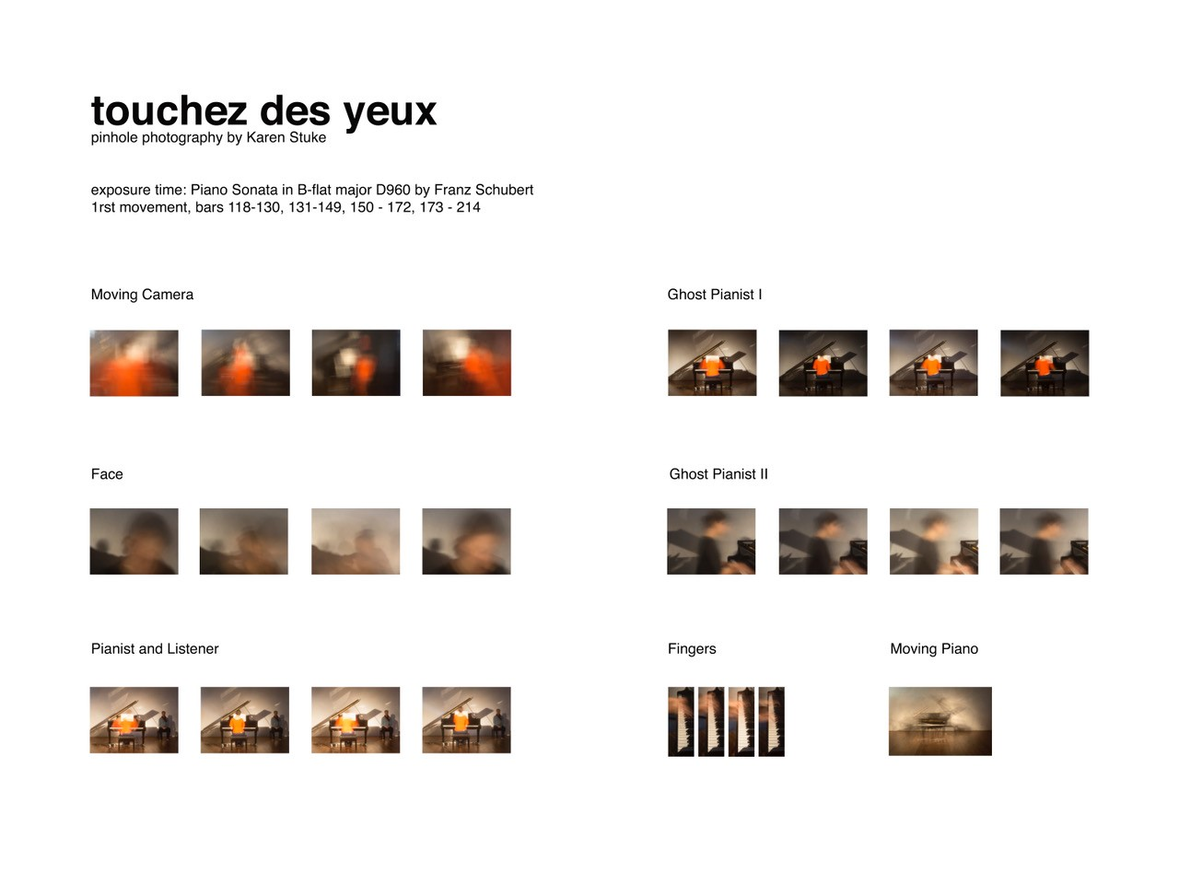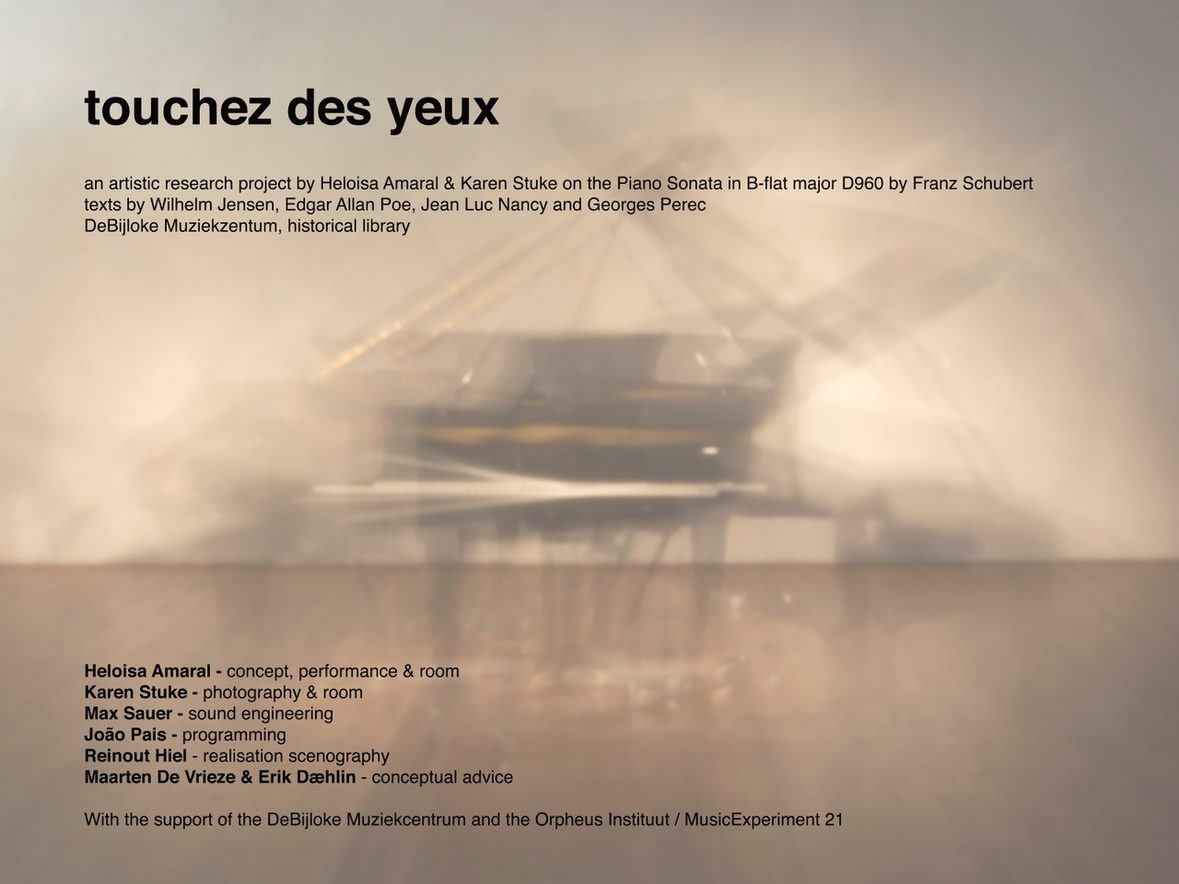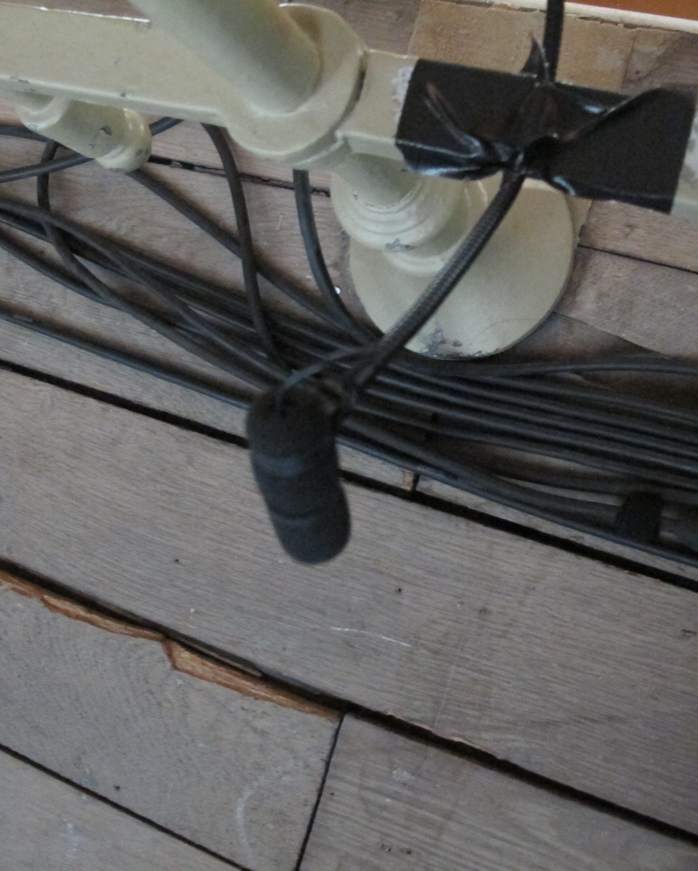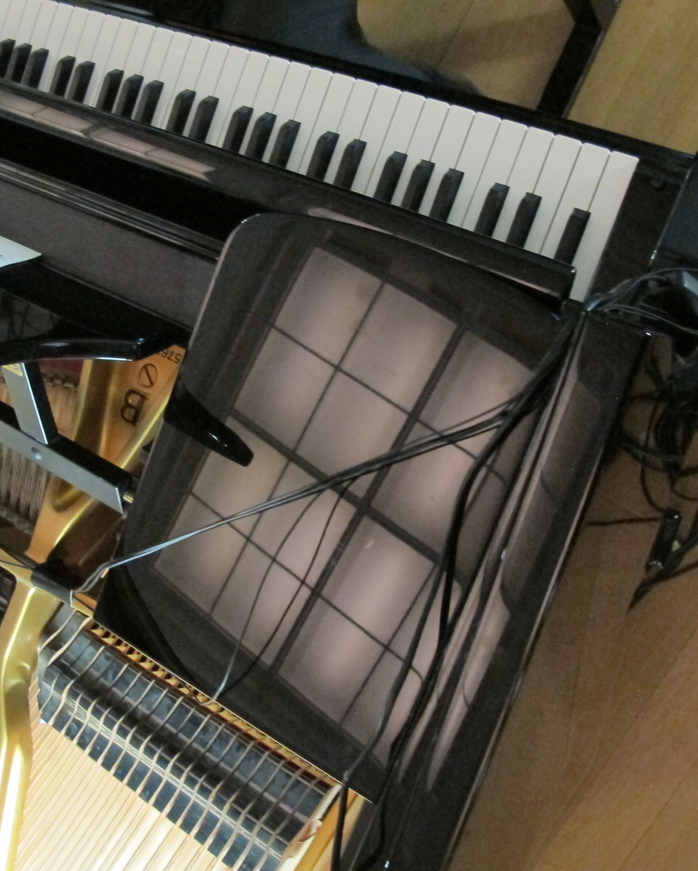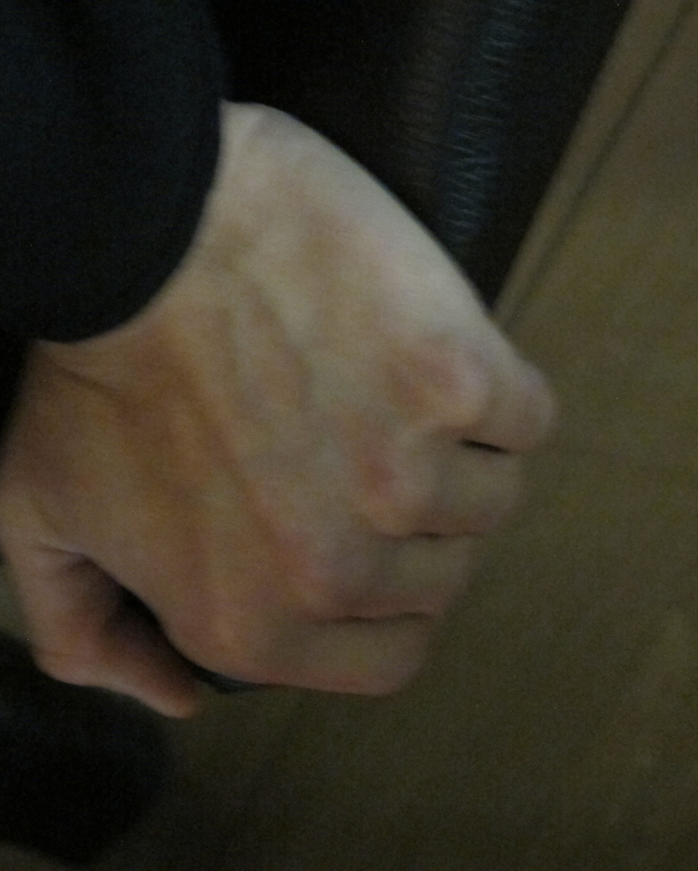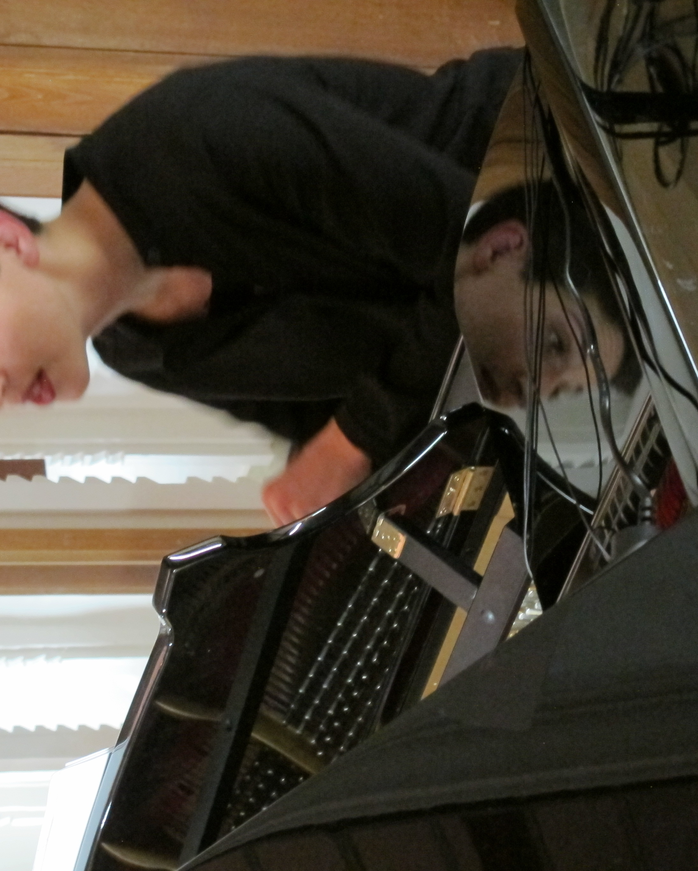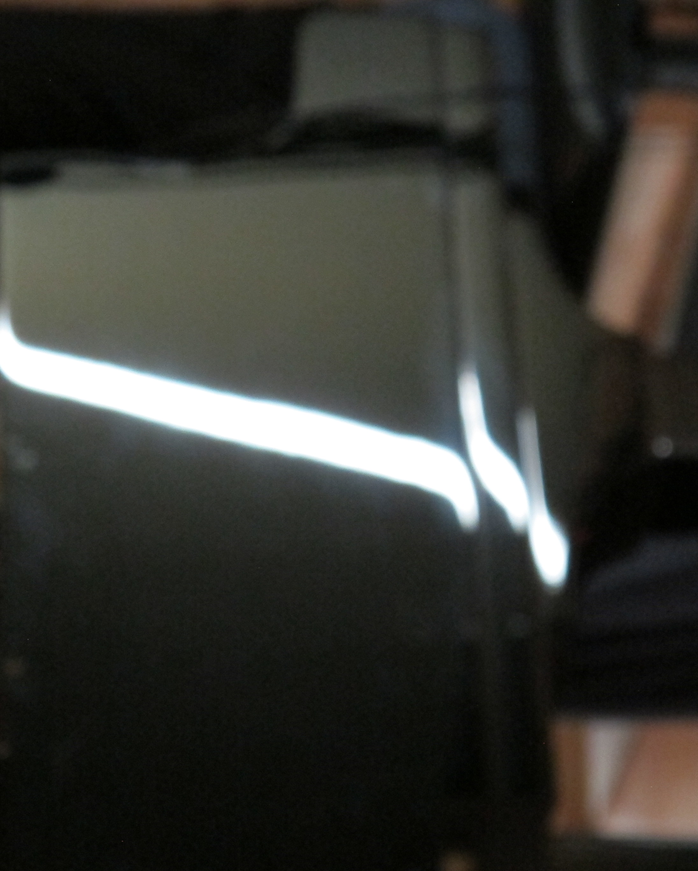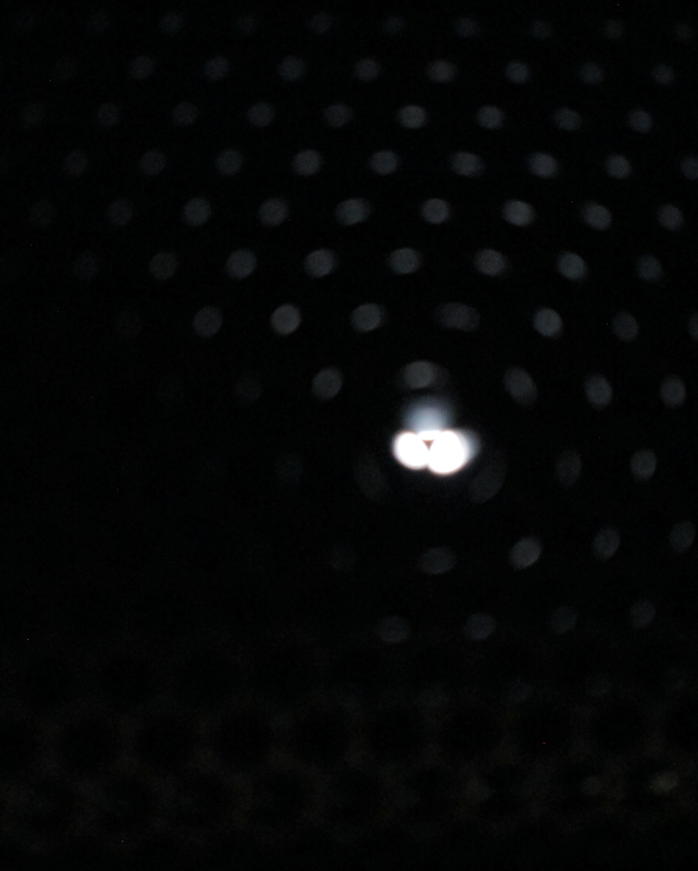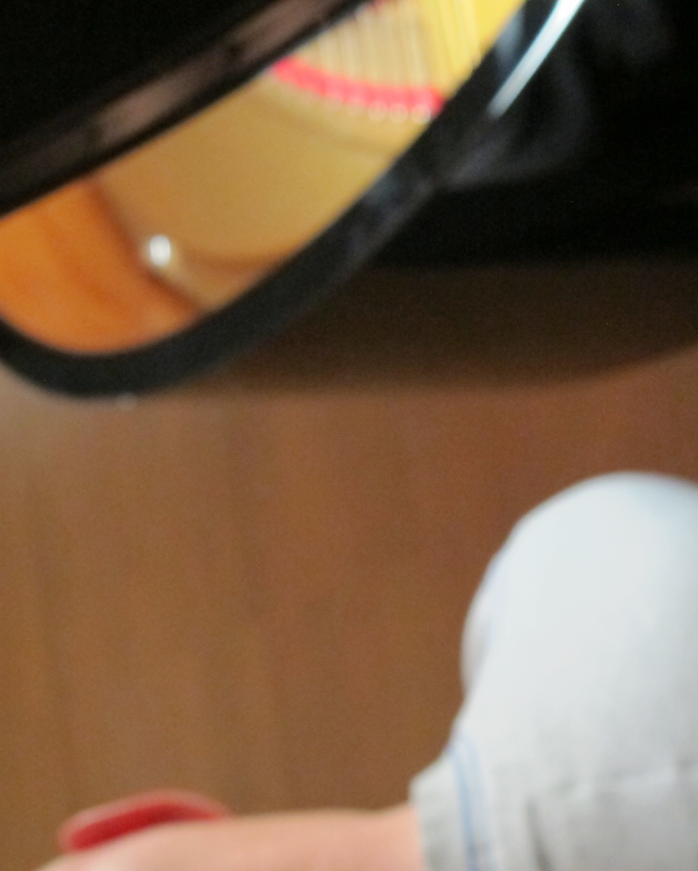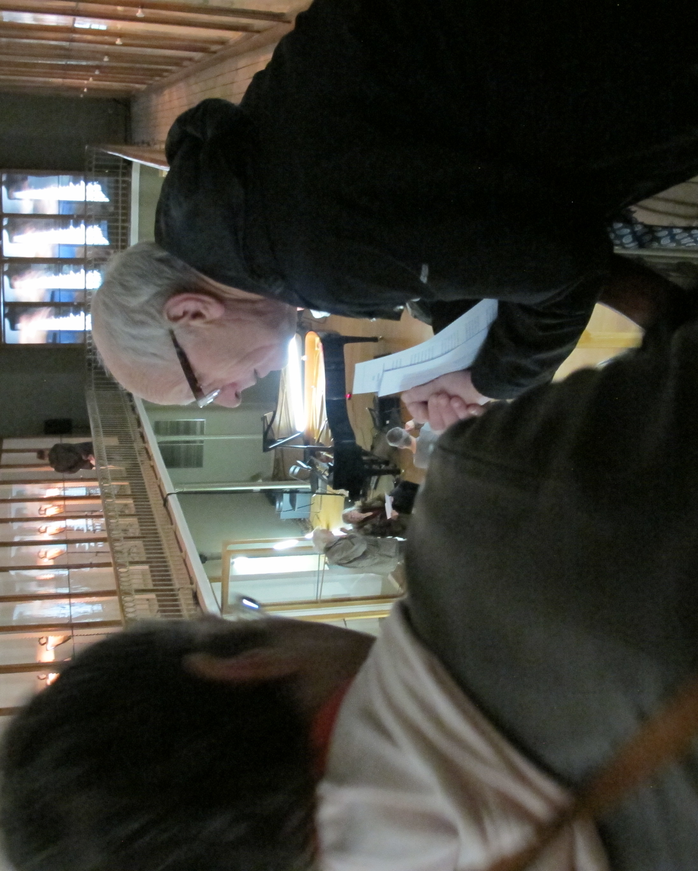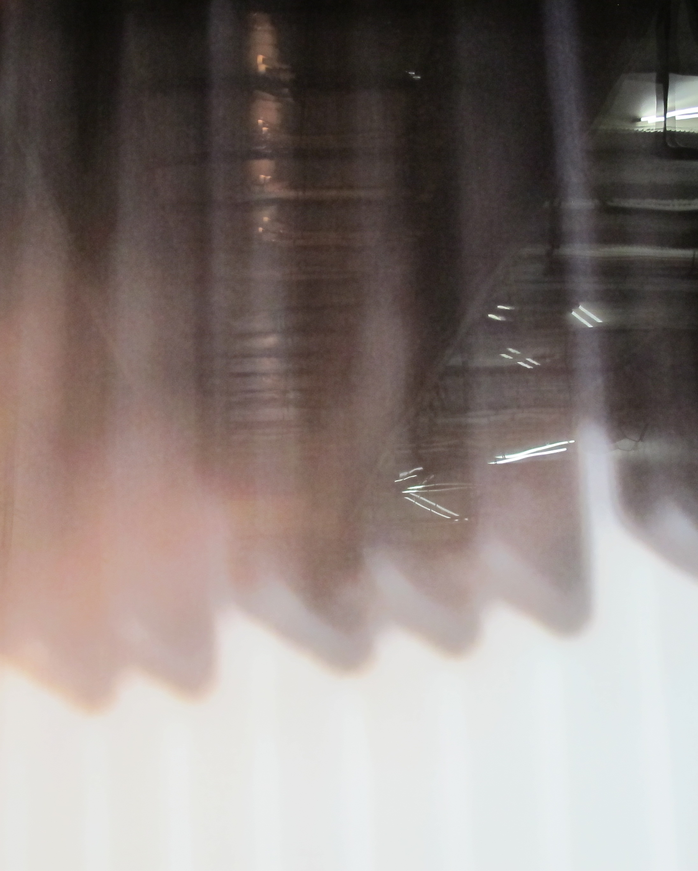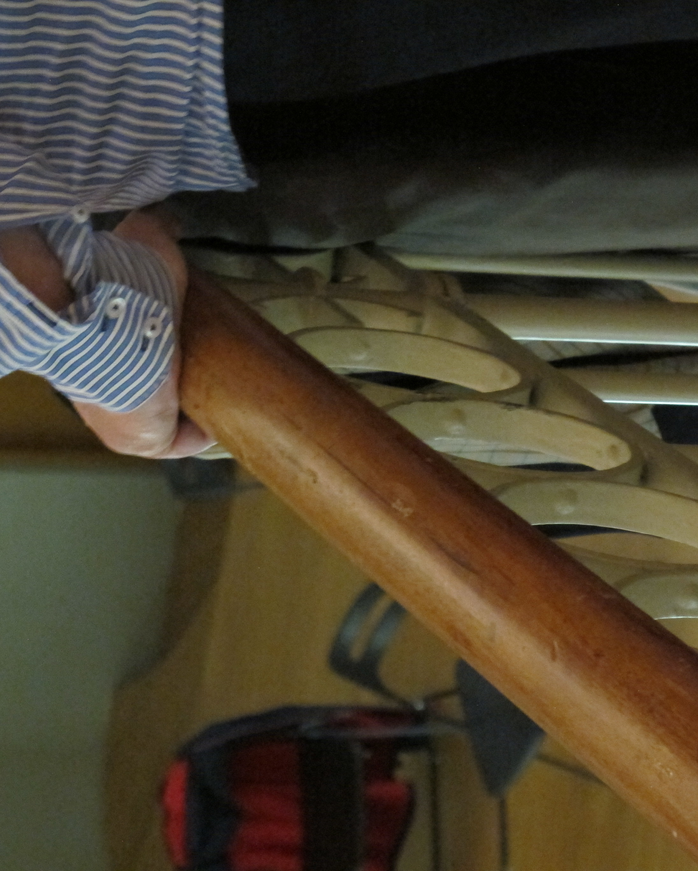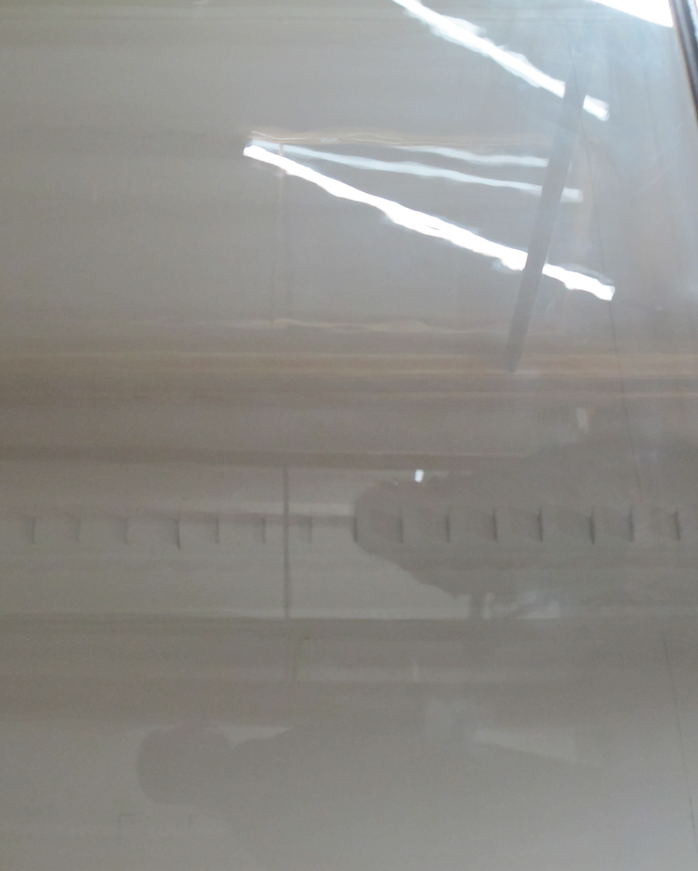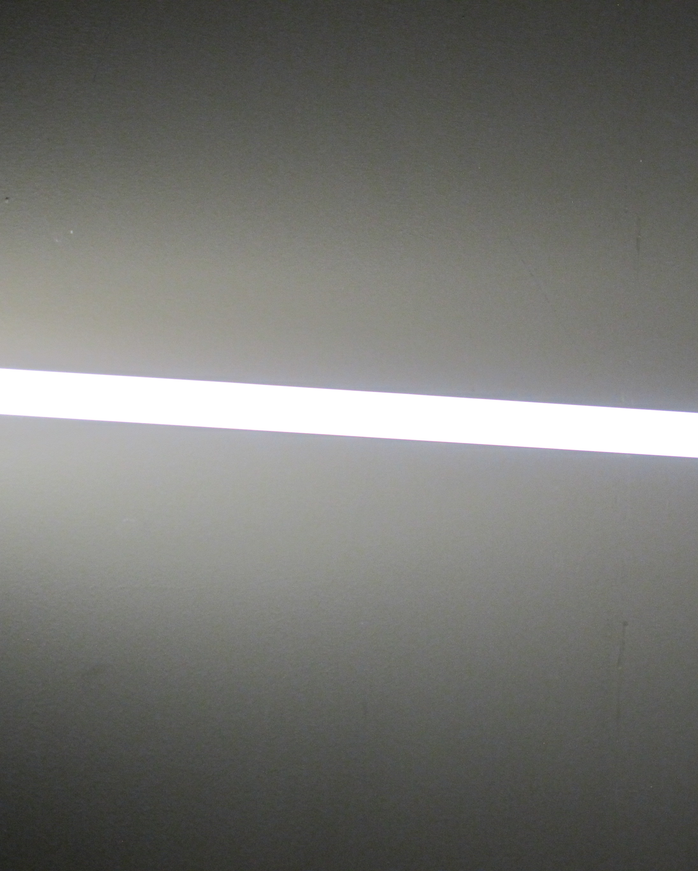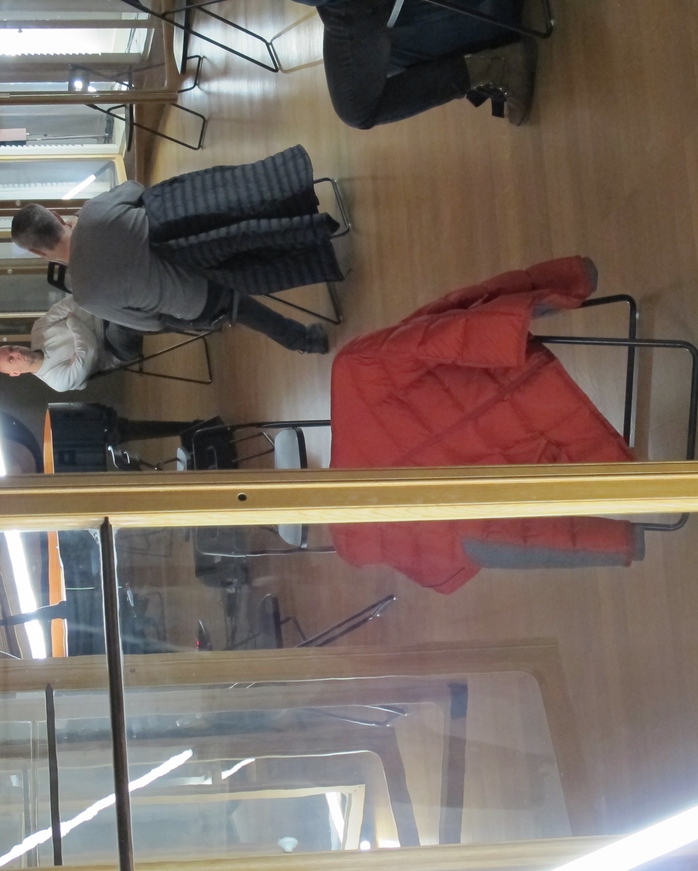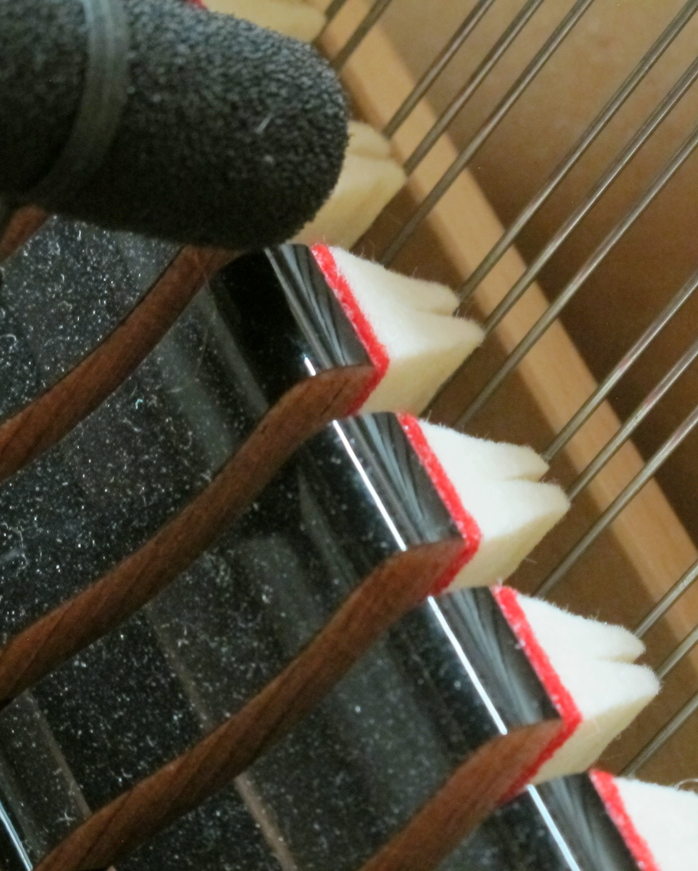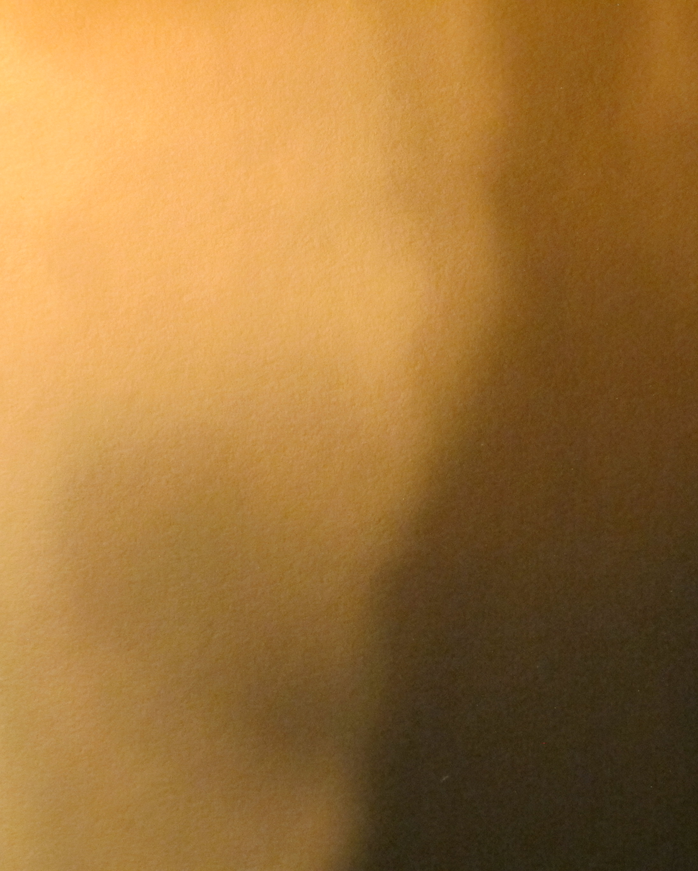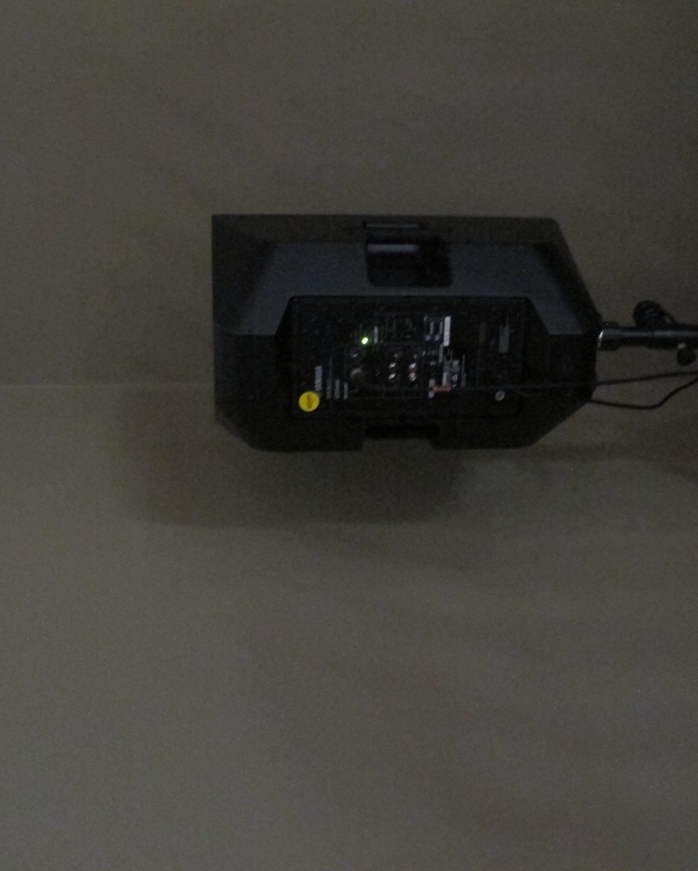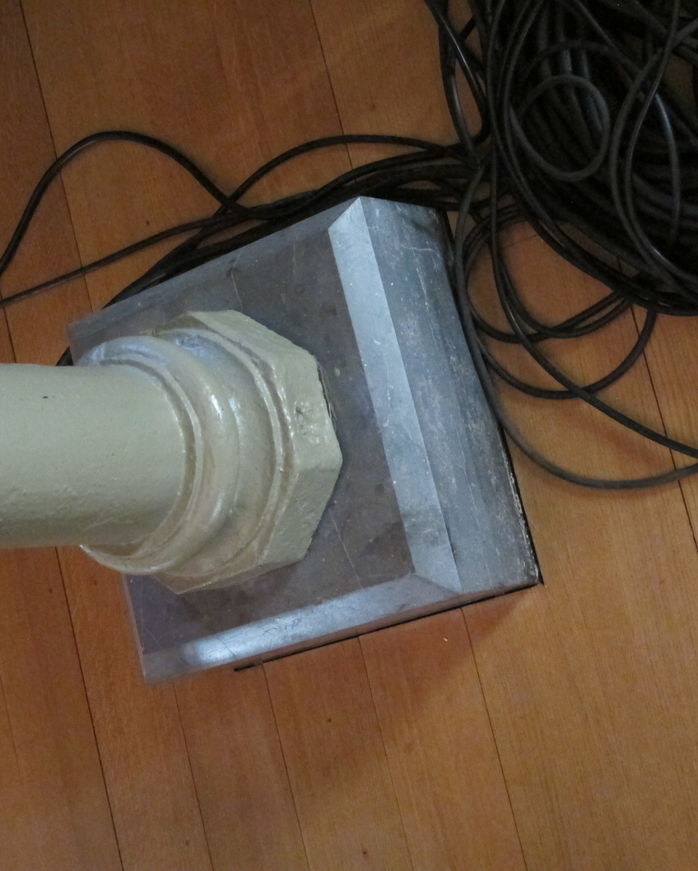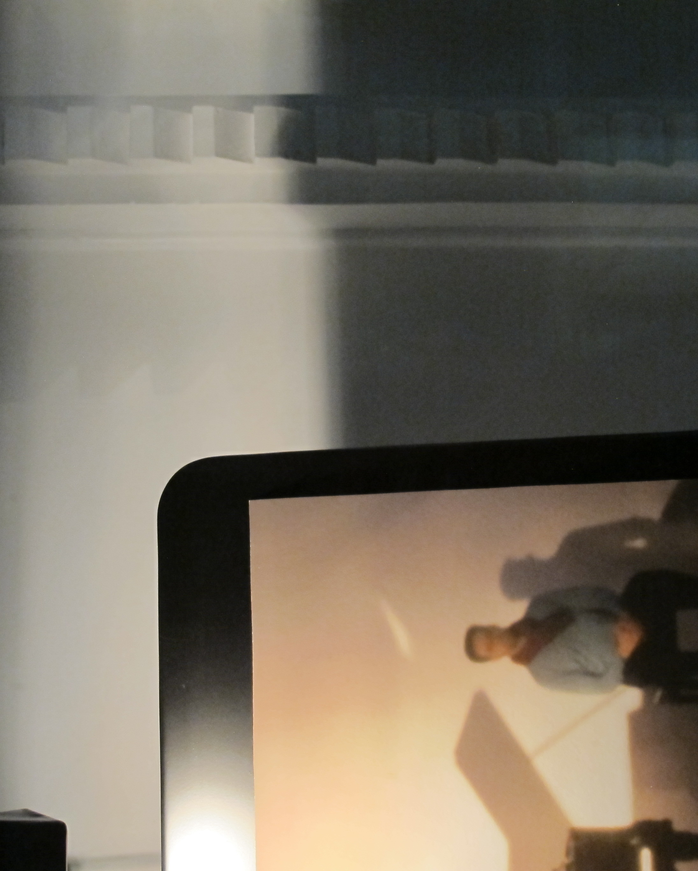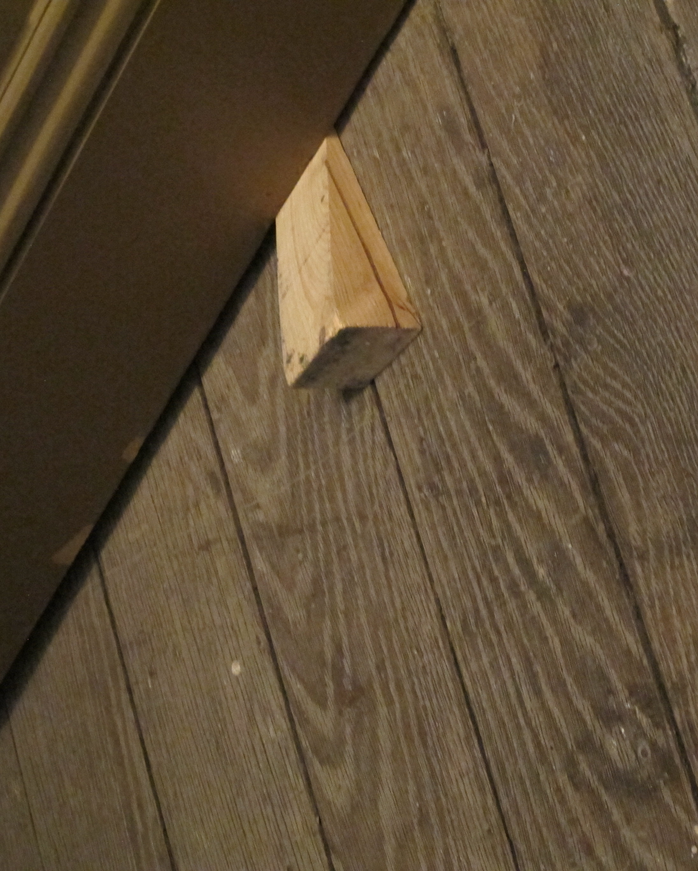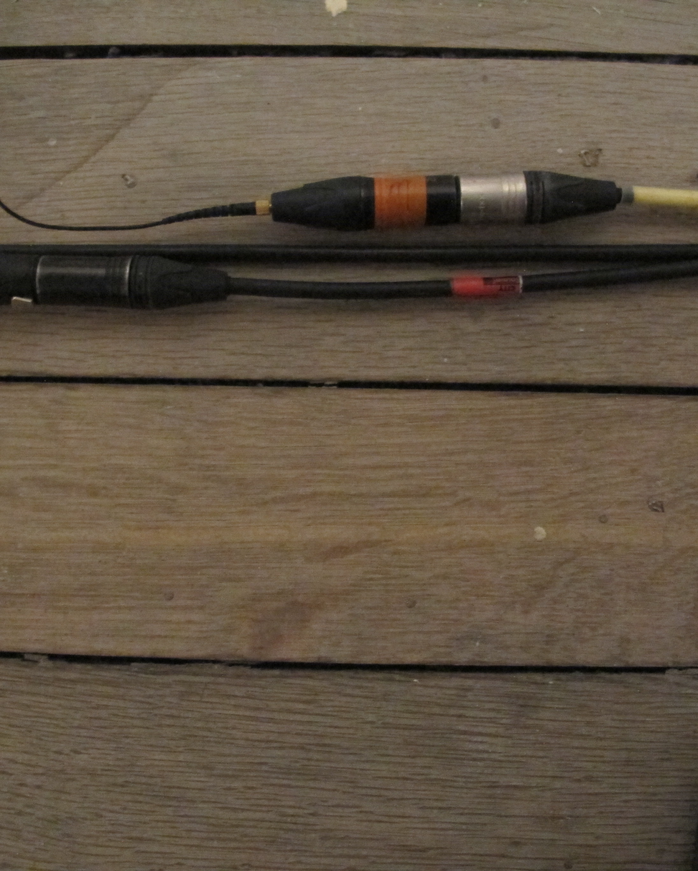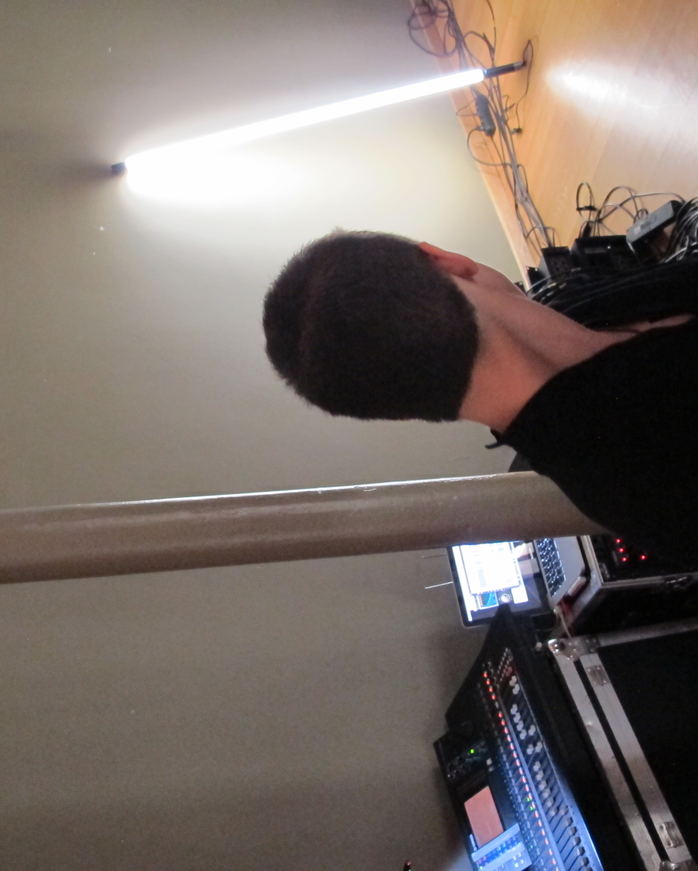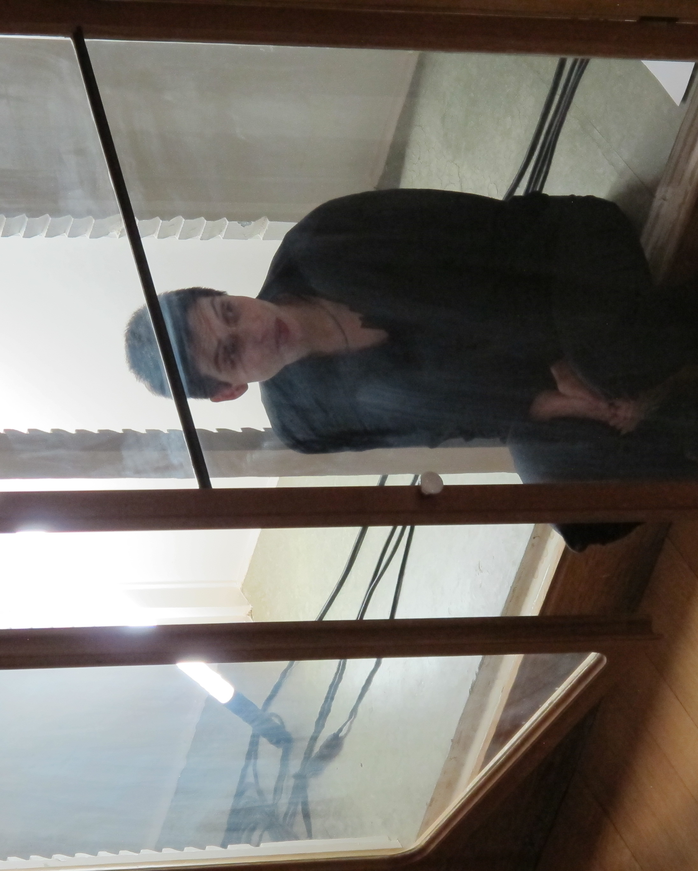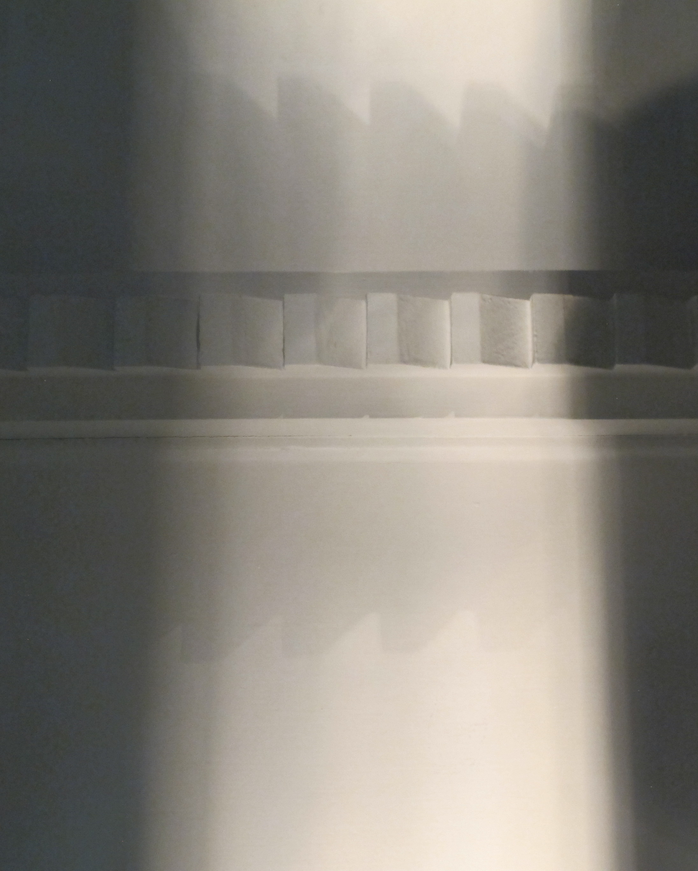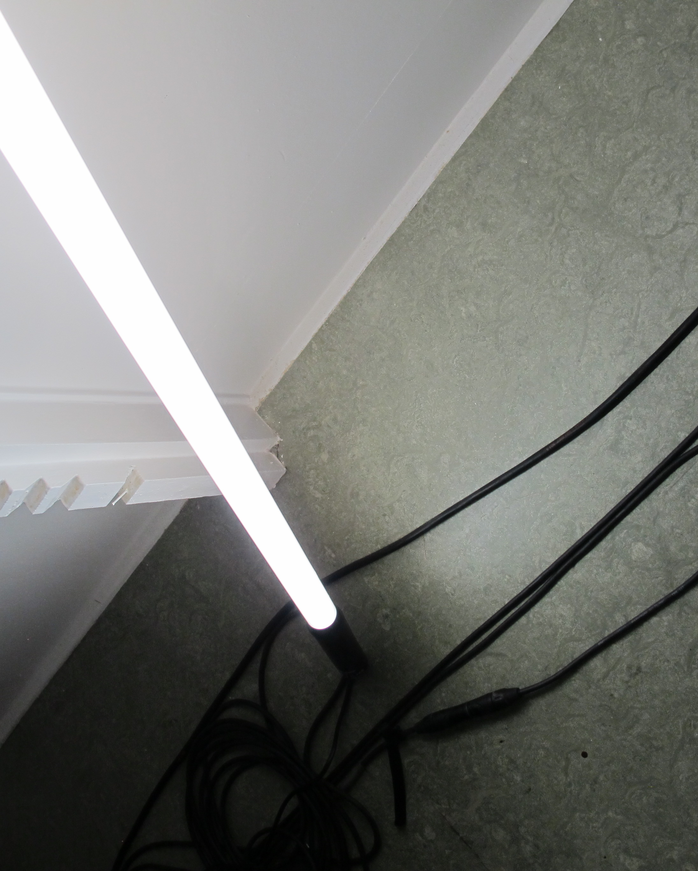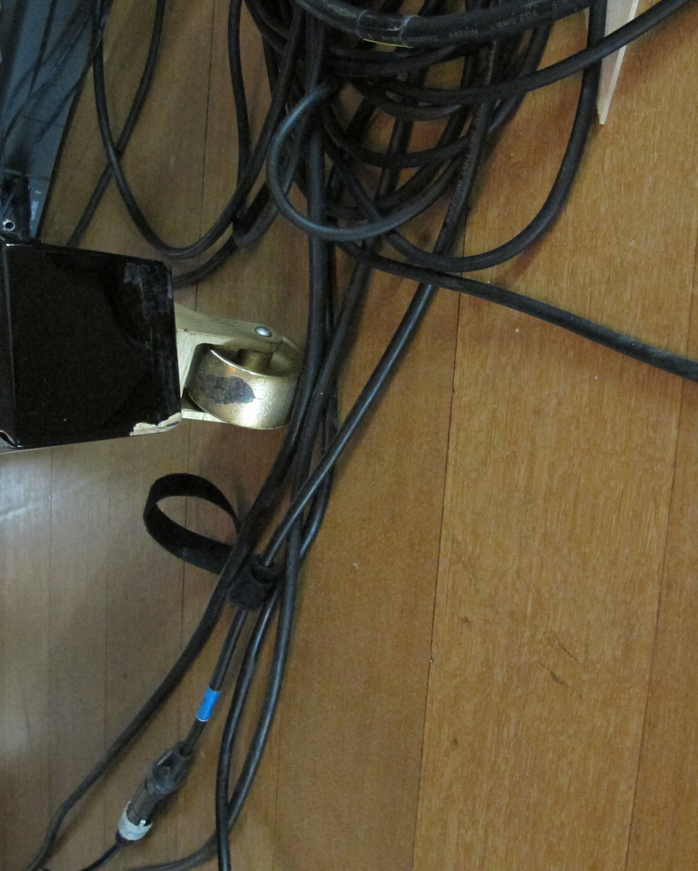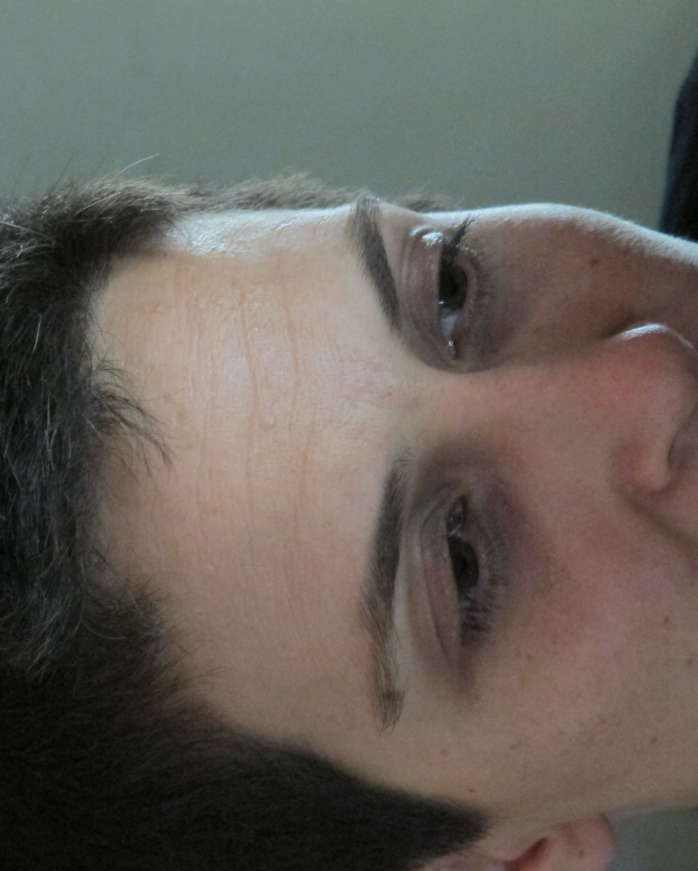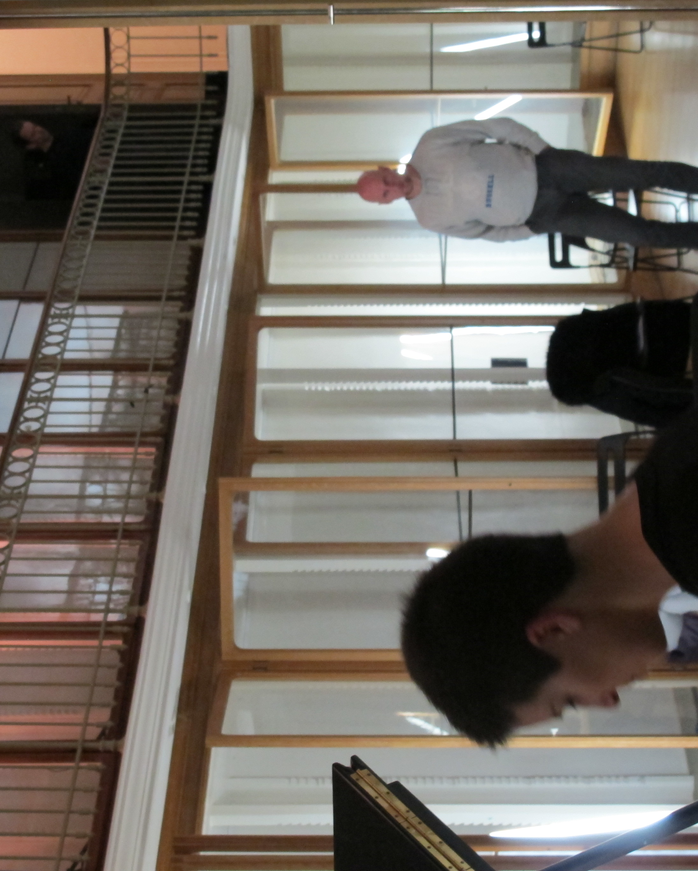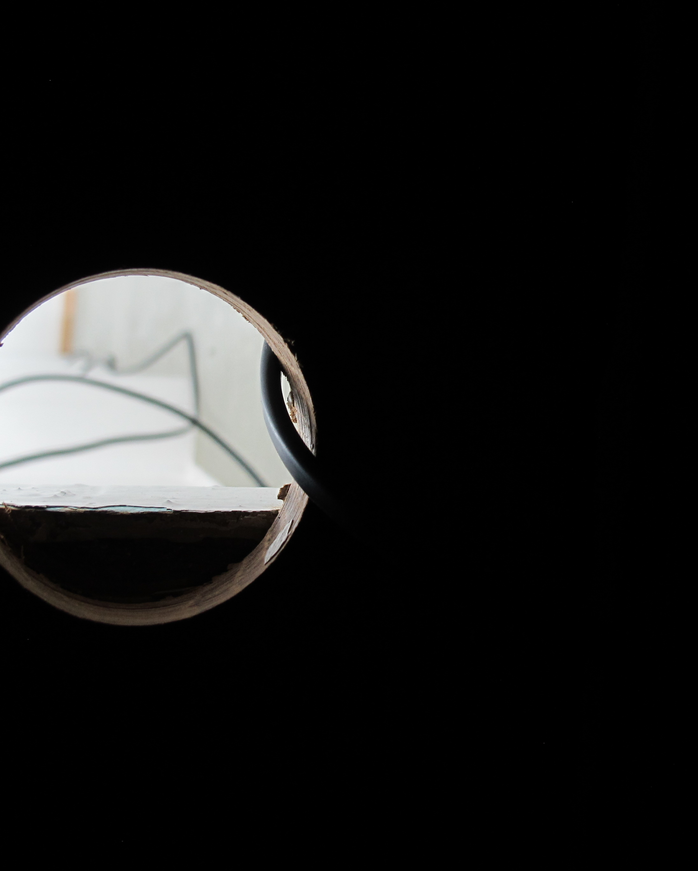This page contains a collage made of fragments of recordings and photographs from the performance touchez des yeux, developed during this research trajectory. The audio collage plays automatically, with many layers sounding at once.This is an intended effect. Sound and video examples from other performances are supposed to be heard by themselves, and the sound collage will turn off automatically when clicking on the play button of these examples. To return to the sound collage of touchez des yeux, click on one or more images of the performances (each image/slide show corresponds to one layer). Due to system limitations, sound might not turn off automatically in some browsers. If this is the case, it is possible to access the examples on a separate page by clicking on the hyperlinked titles in the body of the text.
I have tested the notion of metaxical amplification in two grounded performances, touchez des yeux and Interferences, with varying results. touchez was conceived around the Sonata in B-flat Major D960 by Franz Schubert. It was presented at the historical library of De Bijloke Muziekcentrum in Ghent in eight performances held between 30 November and 6 December 2018 as part of Fröhlicher Franz, a festival dedicated to the music of Schubert.1 The focus of metaxical amplification in touchez was on the narrow performance environment, the space and its acoustics, including the audience, the piano, and my personal role as a performer-curator. Interferences was also a solo piano performance, this time based on Johannes Brahms’s Study No. 5 (for left hand alone) after Bach's Chaconne, BWV 1016. In Interferences, emphasis was placed on the wider environment, notably the surroundings of the venue in downtown Porto. The performance was presented in the concert hall of the Superior School of Music and Performing Arts (ESMAE) in Porto during the IV International Contemporary Piano Meeting in December 2019.
Zooming in on touchez des yeux, the title – in English, ‘touch with the eyes’ – is directly related to the concept of metaxy. As previously mentioned, pre-Socratic philosophers believed that direct contact, or touch, was necessary for sensory perception. Later, Plato and the young Aristotle distinguished between direct senses and senses requiring distance, including hearing and sight. They judged these two categories in terms of their purity. According to this distinction, which Aristotle later rejected, sight and hearing would speak directly to the intellect and the realm of ideas, whereas touch would be our most impure sense (Alloa 2020, 155). The juxtaposition of pure (the eye) and impure (touch) in the title of my performance seemed fitting to the idea of combining vulgar noise with a type of music generally considered as high art. Additionally, the expression ‘touchez des yeux’ refers to a French idiom with multiple meanings. In the imperative mode, ‘touch with your eyes’ is what parents tell their children when they are afraid that they might break something fragile. Touching by sight is also how one relates to museum artefacts that can only be observed from afar, not unlike the deference interpreters show for tradition and the musical past. In the vocabulary of seduction, it is the way lovers look at each other, full of desire. In relation to my practice, touch refers to the pianist’s idiosyncratic interactions with their instrument. In all these cases, the expression indicates a longing for immediate contact with something that speaks to us but that is off-limits, something that is precious and fragile, an object or a body that could transform or be transformed through bare touch. For me as a performing musician and in the context of this research, it is an injunction to lift my eyes (and ears) from the score and the instrument and take a closer look around me: acknowledging the environment I am in; who and what sounds are surrounding me;, what I do, or can do, to this environment; and what this environment does to me.
When it comes to practical implementation, the audience’s space for touchez was amplified through contact microphones placed on the balustrade of the mezzanine and on the library floor, thereby picking up noises such as steps, whispering, and the friction of clothes. Next to this, the space itself – its acoustic fingerprint and sound-reflecting elements – was amplified through contact microphones which were placed on reflective surfaces such as glass vitrines. There was also a pair of condenser microphones hanging from the balustrade that captured ambient sounds whose signals became convoluted with the acoustic impulse response of the space. These signals, played back in real time, acquired depth and a three-dimensional quality. Oftentimes, the conflict of frequencies in the space triggered audio feedback, to which I will return shortly.2
During the performance, I sat at the piano and played the sonata’s first movement, with an array of switches and pedals next to my feet, allowing me to turn groups of speakers on or off, to control the volume of the amplification, and to access a loop function with which I could record and play back fragments of the performance of my choosing. When depressed, most of the switches produced a clear and loud clicking sound that could also be used musically. The amplification system was controlled through a laptop running a Max/MSP patch and a virtual sound card connected to a mixer. The action of the piano became more audible because microphones were placed inside the instrument, close to the hammers, soundboard and pedals. These microphones captured the mechanical sounds that were then played back through speakers placed directly under the instrument. These sounds, which are natural consequences of the activation of the instrument when performing a piece such as this sonata, included the thud of the dampers when the pedal is pressed down and then quickly lifted, the light clicking produced by the hammers when depressing and releasing the keys, the sound of the fingers hitting the keys, as well as the ‘shadow’ sounds of the strings (a barely audible sound like a halo of a tone, produced through a very light and rapid pressure on the keys).
Like Maciunas and the composers mentioned before him, John Cage was also fascinated by ‘noise’. In a talk delivered in the late 1930s, Cage (1961, 3) declares this enthusiasm:
Wherever we are, what we hear is mostly noise. When we ignore it, it disturbs us. When we listen to it, we find it fascinating: the sound of a truck at fifty miles per hour. Static between the stations. Rain. We want to capture and control these sounds, to use them not as sound effects but as musical instruments.
Cage explored his enthusiasm for noise’s potential in a musical context by framing noise within his compositions. Cage did this in a move similar to Duchamp’s, who transformed banal objects such as a urinal into art just by showing it in an art setting. In 4’33, for example, the score only contains breaks, lasting for the specified length of four minutes and thirty-three seconds. In the absence of notated sounds, what one hears during the performance are ambient sounds: the sound of the audience moving, coughing and whispering, the noise of the ventilation system and so on. In sum, the piece explores sounds that one calls noise because they are unwanted in a conventional musical situation. The environment thus becomes responsible for the content and hence the outcome of the composition.
Cage’s interest in bringing noise into the concert hall in pieces like 4’33 represents a form of resistance to the aloofness of music in relation to the real world. ‘When we separate music from life’, he wrote, ‘what we get is art (a compendium of masterpieces)’, where sounds are used as ‘vehicles for man-made theories or expressions of human sentiments’ (Cage 1961, 44). For him, music that was close to life, was music composed in a way such as to let sounds emerge and develop unbridled, without intervening or giving them a purpose and direction. Here this means, as it did for Maciunas, that sounds became audible within the frame of a composition, but without being prepared or provoked by specific actions of the performer. This changed the status of the music from works in which all elements were predefined and precomposed to works that contained open-ended sonic processes. This means that sounds were allowed to unfold at their own and unpredictable pace, like the sugar in Bergson’s water. This open-endedness was supposed to activate listeners and to stimulate them to compose their own listening: ‘The less we structure the theatrical occasion and the more it is like unstructured daily life, the greater will be the stimulus to the structuring faculty of each person in the audience’(Cage 1965, 55).3
4’33 is a good illustration of how Cage would thereafter compose without ‘structure’: although the situation of the performance is tightly structured by the specified timeframe of four minutes and thirty-three seconds, as well as by the spatial positioning of performer and audience in the concert hall, the sounds that one hears are not pre-defined, and emerge ‘spontaneously’ from the situation. His motivations for writing the piece included a concern about how living in a daily soundscape increasingly dominated by muzak and noise was numbing our ears and ability to listen. In this context, listening in a focused situation to apparently banal sounds proposed a ‘non-codified space of reflection’ (Daniels and Arns 2018, 16), which could teach people to be more present to the world and mindful of their sonic environment. Such an attitude and agency could then be transported and exercised outside artistic situations, that is, in everyday life. In short, the sensibility of the listeners for their surroundings would be heightened and so would their general openness to sounds. As sound theorist Brandon LaBelle (2018, 45) proposes, noise as used by Cage becomes an ‘open horizon’ in the sense that it oversteps certain limits, pushing boundaries regarding what belongs or not to the musical space, and expanding one’s listening palette.
Returning to the ‘collateral noises’ emphasised in Steen Andersen’s rerendered, his unusual usage of the pianodenotes a search for alternatives to what one could describe as an aesthetics of ‘pure tones’. In this search, which Steen Andersen shares with many of his contemporaries, Helmut Lachenmann’s musique concrete instrumentale was pioneering. Lachenmann attempted to distance himself from the bourgeois ideal of an immaterial music by treating classical instruments as sound-producing machines in the widest sense, identifying and rendering audible their noisy potential. Take the examples of Guero (1970), in which the pianist scrapes sideways over the keys to create a rattle sound reminiscent of a Latin American güiro, or Got Lost, discussed in the Introduction, where the pianist is required to play pizzicato on the strings, to press the pedals down very loudly, to scratch the strings with their nails and knock on the wooden frame. Since the last half century, with the development of microphoning technologies, it becomes even easier to integrate these types of sounds in a composition, as I have shown with the example of rerendered. Also, these technologies are themselves instruments that produce their own sounds beyond the sounds they transmit (see also the example of Paul Craenen's tubes below).
Leaving these musical examples aside for a moment, when one acknowledges noise as musical sound, noise becomes performative not only at an ideological, but also at a perceptual level. Pierre Schaeffer has composed in this vein. Inspired by Varèse’s interest in new sounds and scientific research, Schaeffer used measuring and editing technologies that were developing in the 1940s to transform recordings of trains, spinning tops, saucepans and other objects into musical compositions. Schaeffer’s way of dealing with these sounds in a musical context, was to disconnect the sounds from their material source by editing away the ‘beginning’ of the sound, usually called ‘the attack’, or by using repetitions, so-called ‘loops’, of fragments of recordings. Not knowing the cause or origin of the sound made it easier to focus on the musical properties of these sounds, on their duration, pitch, timbre, register and intensity. In Schaeffer’s words, this approach made digestible and musically exciting sounds that would usually be negatively considered as noise:
I was much more interested in the search for natural sounds, in their natural history, in what a sonorous body tells when it sometimes performs its little symphony; all that which we so improperly call noises, because there is nothing more organised, better organised than a noise. (Schaeffer 1979 n.p., my translation)
Schaeffer’s approach to sound was not very different from Cage’s, for they were both influenced by phenomenology and the contemplative attitude that it promoted. In other words, he understood listening as a contemplative and non-judgemental attitude that seeks a direct contact with sounds independently of their function and meaning. It was this absence of judgement that allowed him to think of noise as musical sounds (Schaeffer 2017 [1966], 208-209). Other composers were more interested in thematising the way in which a banal sound could become ‘musical’. In Variations pour une Porte et un Soupir (Variations for a Door and a Sigh, 1963) Schaeffer’s colleague and contemporary Pierre Henry presented the 'doorness' of a door by starting with the clearly recognisable sound of a door creaking, before transforming and musicalising the sound until its physical cause became unrecognisable. It is in this tradition that one can also place the music of Catherine Lamb, mentioned above. Her works are like perceptual exercises in which the volume and degree of clarity of the street sounds oscillates from being distinct, with recognisable sources, to barely perceptible, in which case they sound like a shimmer, a soft tremulous sound wrapping the keyboard tones.
Finally, in addition to these examples, I also recognise a tendency in some of the newer works that I perform to simply stage noise ‘as’ noise, without trying to make it musical. This is perceptible in the way composer and turntablist Marina Rosenfeld conceived her piece for solo piano and electronics piano and work (dominoes) from 2019. piano and work is more like a situation or a tableau than a piece in the traditional sense, for what I do during the performance is teaching myself to play a piece by Rameau. In the background, I hear noises produced by Rosenfeld’s turntabling as recorded in the electronics part: the screeching of LP-player needles or the soft crackling when a record ends. These noises are meant to inspire me to explore similar sounds on my instrument. Progressively, the exploration of Rameau’s piece is transformed into a three-part improvisation, including – besides the traces of Rameau’s music – vestiges of turntabling, and the piano’s mechanical noise. Thus, the noise of the media shines through both my performance and the recorded material, thereby exposing the generally concealed media. Indeed, there seems to be a growing interest in glitches and inconsistencies in contemporary compositions, as represented in Rosenfeld’s work by the cracklings and screeching of her turntabling or the fragmentary performance of Rameau’s piece (Amaral 2020a). These can be understood as a resistance against the ‘excluded middle’ precept in musical mediation and the way in which this form of mediation deals with the noise of the media, which it erases or minimises. These glitches can also represent an alternative to the ever-polished approach to sound by the record industry and the field of classical performance. Another example is Ida Lundén’s ba-ro-me-ter - Variations in air and sound pressure (2017) for violin, piano and historical records, written for Duo Hellqvist/Amaral. The piece uses as material one of the first recordings of speech – the word ‘barometer’ – registered by Charles Tainter and the Bell brothers in 1884. As is characteristic in old recordings, one hears a great deal of distortion and hiss. In the piece, violin and piano freely echo the fragments of the historical recording, by imitating and improvising upon its noises and the practically indiscernible words. Lundén’s enthusiasm for historical recordings has certainly much to do with her being weary of the contemporary hi-fi aesthetics as discussed in Chapter One, and with her search for new impulses in the ‘imperfect’ sound world of historical media. In both Rosenfeld and Lundén’s works, noise is not made to be ‘musical’ because it is used as interference, as a means to interrupt. In this way, one is forced to relate to what is normally considered burdensome – noise from old recordings or surface noise from LPs – at the same time as one is made to pay a different kind of attention to this noise, looking for the poetical in the muddy and the defective.
To sum up, there are various ways in which noise can become performative when integrated into musical compositions. It ‘de-brackets’ music, taking it off the pedestal of high art. It breaks expectations, encourages spontaneity, prevents the fixation on meaning and renews the attention towards physical phenomena in space and time. It expands the sonic sensibility of both performer and listener, also in terms of historical imagination.4 In addition, noise is performative in the way that it leads performers to question aspects of their practice and move them out of their comfort zones.
Before specialising in contemporary music, I was trained as a classical pianist, performing repertoire from Baroque to Modern music. Music, for me, consisted of tones organised in time, eventually also of sung text. The sounds of wind, chatter, and passing cars were out of place in this musical universe. At my instrument, I avoided producing mechanical noises as much as possible, aiming at a perfect mastery of the instrument and my fingers, and, above all, striving for precision. Precision means, among other things, a clear attack and contour, hence a noiseless sound. As pianist Vladimir de Pachmann (Cooke 1999, 82) once said, ‘[e]ach note in a composition should be polished until it is as perfect as a jewel’. In some of the examples above, however, such precision is either not desired, impossible to obtain, or sometimes both. For example, the collateral noises in rerendered cannot be clean and sparkling, because it does not lie in the nature of the sounds to be so. This form of imprecision is psychologically demanding for performers who would like to have perfect control of their tools. Yet, imprecision belongs to the dramaturgy of this piece, rooted in the exploration of the tension between the precision of the tones and the inaccuracy of the collateral sounds. The impossibility of having control produces a sense of liveness, an acute focus on the temporal and physical environment of the performance, because the instrument becomes an unpredictable partner. With time, I have learned to indulge in such marginal, ‘dirty’ sounds and to appreciate the element of surprise that they bring to the performance.
Prior to performing such works, I firmly believed that I could not produce a beautiful tone without imagining one beforehand. Following the precepts of audiation discussed in Chapter One, I worked hard to construct a mental representation of the sound I wished to achieve from the reading of the score, memories of previous experiences and my own idea of how the music should sound. In other words, my practice consisted, mostly, of planning and control, and of rendering musical sounds that had been formed and imagined in a sometimes very far away past. However, my priorities changed when engaging with noise. In the compositions described above, I was forced to perform differently. I played in function of what I heard and not in function of what I had planned to hear or what I could read in the score, especially since the score – when there was one – did not always indicate what some of the sounds in the composition should sound like, or even what they were, as is the case in 4’33. In other words, I reacted to what I heard instead of evaluating it in function of a predetermined interpretation.
Returning to the examples described in the beginning, in each of them, noise mobilises the performer in the present. Huber ‘de-brackets’ the performance situation and inserts it into a larger environment that I as a performer can acknowledge and hear; in rerendered I am reminded of the materiality of the piano, which is generally forgotten when I play only tones; and in Lamb’s prima interius I interact directly with environmental sounds. In all of these pieces, I cannot prepare my actions as I am used to, that is, by imagining how they should sound. As I have argued so far, one of the major affordances of noise is that it resituates my musical experiences in the now. Firstly, through the entanglement with the materiality of the performance, and then through the works themselves, which have taught me to relate differently to the sounds of the piano, to the performance context in general, as well as to a different way of listening. These works have trained me to listen in function of the sounds I produce, instead of acting in function of the sounds I imagine. Thinking back on these experiences, my concern with the technical mastery of my instrument slowly superseded by pursuits involving new forms of virtuosity, many of them revolving around the idea of expanding my attitude towards listening. As a result, I have become more attentive to sound, to all kinds of sounds. Along with that, I have forgotten the (negative) meaning of noise: I appreciate listening to sounds that I previously considered to be noise. Attempting to capture in words the general approach to sound that I have developed, I would say that I have learned to ‘touch’ the sounds with my ears, imprinting myself on them, becoming the sounds, feeling their context through an imaginary symbiosis, and letting this feeling guide my doing and being. These experiences are very difficult to describe because they are fragile, fleeting and extremely subjective, but trying to formulate them for myself was the beginning of the artistic projects which I will now present.
touchez surprised me positively for the way the performance uncovered the musical potential of a space as a medium and source of interface for sound production, and as a sound-producing agent in its own right. This was largely due to the unpredictability of audio feedback. Sensing the possibility of a new interference, both my body and that of the listener were kept in a state of alertness, attentive to the physical now of the performance and its possibilities (or threats). In this sense, like the performers in tubes, although I had pedals at my disposal to control the system, the system also controlled and played me.
Further examining the differences between the two projects, while touchez was rich in ideas and discoveries, its implementation was inconsistent and its texture too dense to allow me to recognise and properly explore the possibilities of the metaxical amplification. On the other hand, reflecting on these inconsistencies has helped me to better understand and delimit the scope of my research, leading to the creation of Interferences one year later. Interferences was a project that was technically and scenographically less complex but also more productive in terms of the impact it had on my practice, on my reflections and on the experience of the audience, to which I will return in the next two chapters.
What had been inconsistent in touchez? By creating a peripatetic space, I had wanted to give the audience the possibility to act upon the performance. For this reason, I had conceived of the amplification system as an interactive machine fed by the sounds produced by the performer, the space, and especially the audience as they moved around. As such, the amplification of the audience depended also upon their ‘adequate engagement’ with and within the space. It was crucial, for instance, that visitors would move enough so as to activate the space and produce a perceptible sound mass. If the audience sat still or if there weren’t enough people in the room making noise, there would not be much interference. However, in analysing the performance, I realised that the way I had wished to engage the audience in the making of the performance, successful or not, was incompatible with my initial motivation.
Why was my plan for the audience problematic? The notion of metaxical amplification is based on the idea of making audible the sonic environment of the musical performance. In touchez, the elements that I chose to amplify included the audience, the action of the piano, the acoustics of the space and my personal role. Following the logic of my own concept, the environmental sounds of the performance should have been amplified ‘as they were’. However, instead of trusting the environment to sound on its own, I forced the environment to submit to my intentions, notably by asking the audience to move around so that they would produce enough sound and hence create instability in the space, which would then give me the opportunity to deviate from my planned interpretation. This was a crucial mistake that complicated my research in various ways, deviating my focus for a long time from the mechanisms and determinisms of listening. This deviation left its marks in the performance, creating inconsistencies such as feeling awkward and impatient when people did not move, encouraging the audience repeatedly to explore the space, as well as demonstratively and purposefully inducing feedback to produce interferences. Even though the result of this behaviour was, compositionally speaking, not uninteresting per se, I had ended up doing the exact opposite of what I would have liked to happen, namely taking full control of the situation instead of letting myself be played by it.
The introduction of texts in the performance was also not consonant with the metaxical concept. The passages from Perec, Poe and others were meant as a metaphorical amplification of my personal role, and more specifically of my discomfort with the traditional role of the performer of classical music. However, this did not work well because what I amplified were thoughts well-formed for the occasion but not for the materialisation of ideas occurring to me spontaneously during the performance. As such, my words came across as very rehearsed and ‘processed’ in contrast to the spontaneous and improvised nature of the musical interaction between the Schubert sonata and the sounds of the environment. For this reason, my spoken interventions functioned as a metadiscourse rather than as another layer of amplification. Since the texts were denouncing problems such as the performer’s obsession with the past or one’s inability to see what lies before one’s eyes, they sounded like directives for the audience, telling them how to understand the performance and how to relate to it. Therefore, they turned the emergent interferences into an illustration of my words instead of an opportunity to listen differently. For me, the fact that these texts became a commentary on the performance rather than an integral part of the performance was problematic for two reasons. First, because, as Jacques Rancière (2009, 85) writes in The Intolerable Image, this kind of critique remains within the logic of what it is criticising. It does nothing but warn the spectator about their naïveté and establishes as universal a problem that was first and foremost my own dilemma. In addition to distracting the audience from the possibility of engaging with the situation as they saw fit, it prevented me from fully being in the moment as I had planned. It is one thing to react to the environment through my playing, and another thing entirely to react while both playing and reciting prefabricated texts, not least in terms of multitasking virtuosity. Naturally, I had the choice to react by modifying both the texts and the musical interpretation of the sonata, which I did to a certain extent. But again, like with my desire and expectation to let the audience move, I was interfering with my own concept, dissolving it together with the coherence of the artistic experiment.
The second idea behind touchez was to highlight the ambiguities of the performance situation. The many layers of the performance (playing, noises, texts, photographs, movements) might have had the effect of creating even more ambiguity. Conversations with the audience and reading one of the reviews (Vanderhaeghe 2018) revealed the impact of this layering. Instead of creating a division of presences among the different elements of the performance, what seems to have occurred was that the many layers reinforced the focus on the sonata. Unable to find their way through the dense texture of the performance, some of the spectators looked for familiar references, which appeared in the moments when the sonata was played rather straightforwardly. Yet, because these moments were few, the audience was left frustrated. Now, while frustration is not necessarily a negative thing in the context of an artistic presentation, I had aimed at evoking a different kind of tension. As theatre director and composer Heiner Goebbels (2010) explains, the absence of a main theme or storyline can be productive. This absence can activate the imagination of the spectators as they try to fill in the blanks, or it can provoke a form of tension connected to a desire to experience what is absent or no longer central. Goebbels gives as an example the body of the protagonist in his play où bien le débarquement désastreux. In one of the scenes of the play, the protagonist is hidden behind a giant structure of aluminium hanging over the stage. Aware of the presence of the actor but unable to see him, the audience becomes even more curious. However, that which keeps the viewer on their toes and wanting more, can also cause negative ‘withdrawal symptoms’ (Lehmann 2006, 169) that might translate into a loss of general interest for the action. This is what ended up happening in touchez.
Finally, there were some technical issues in the performance including the soft volume of the amplification and how the 3D-amplification overshadowed other sounds. I had wished for a subtle amplification, just loud enough to heighten the awareness of the space and the sense of physical presence of the performer and the audience. However, instead of reorienting the attention, the imperceptibility of some sounds and their haziness, notably where rhythmical impulses were concerned, created an immersive bubble instead of a lively environment. In other words, I intensified the general attention but did not effectively change its focus.
In contrast with touchez, in Interferences I looked for more crispness and concision in the implementation of metaxical amplification, which is why I decided to amplify one element only and not several at once. The space was clearly structured around the traditional configuration of auditorium/stage, with dark lighting, and with the only scenographic intervention being a few spotlights that shone not only on the performer but also on the auditorium. The sound of the piano came from the stage only, whereas the loudspeakers playing street sounds were positioned laterally in relation to the audience, so that the origin of the two sound sources would be maximally distinct. This was a simple solution that respected both the concept and the technical possibilities available at the theatre. The Chaconne by Bach as arranged by Brahms is for left hand only, and except for sporadic broken chords, most of the piece consists of a bare melodic line. The precision of the spatial and sonic arrangement was meant to create a one-to-one exchange between the street noise and the solitary left-hand line. The audience also had a more conventional role in the sense that they remained seated in the ‘sit still and listen’ (Rebstock 2011, 143) position of the traditional classical concert. However, in searching their way through the pronounced sonic chaos of the situation, they were auditorily more active than in touchez.5 This allowed the focus to be on the experience and interaction of the two auditory layers – the piano sounds and the street sounds.
In the next chapter I offer a more detailed description of how the listening activity unfolded in-between these different layers. Instead of focusing on creating for oneself a coherent interpretation of a musical work, one listens and performs amidst fluctuations and instability. Listening in such a context complexifies and problematises traditional notions of attention and raises questions about the general involvement of the performer and listener in the musical event. This includes looking back at the improvisatory activity of the performer as described above, how it entangles with traditional musical interpretation, and how this entanglement allows me to recover a sense of presence. This sense of presence is something that I, through the metaphor of Stuke’s pictures, had deemed lost. This reflection will lead to a final chapter in which I discuss how the autonomy and aesthetic self-sufficiency of the musical work, as presented in Chapter One, is replaced by rethinking the musical work as inseparable from the environment – or ground – upon which it is (re-)presented. In other words, the musical work emerges from the present rather than being realised in it.
Metaxical amplification is an audio system that I designed to amplify the ‘noise’ of a classical music performance. The concept of metaxical amplification comes from the Ancient Greek metaxy (literally, the ‘in-between’), a term that comes up in Aristotle’s writings on sensory perception (cf. Alloa 2020).Before Aristotle, pre-Socratic philosophers used to explain all sensations in terms of touch and direct contact between the sensory organ and the sensed object. Something would need to literally touch the eye for it to be seen. Aristotle, however, however, defended the importance of an external mediating agent in sensory perception. In On The Soul (1995, 1787) he insists that something must be in-between my eyes and the object that I see. If this were not so, I would not be able to see the object at all, for it would coalesce with my eyes, blocking my vision. He referred to this mediating agent as metaxy, that which stands between the sensory organ and the object of perception, surrounding or enveloping both (for instance air, flesh, or saliva).
Metaxically amplified performances are concerned with the performance environment, understood as a necessary agent for the perception of a musical work. Unlike in conventional performances, this environment does not need to ‘disappear’ in metaxically amplified performances . Rather, the environment and the various elements that compose it can remain perceptible during the performance, not only as a support to the music but also as an idiosyncratic agent. Thence, noise becomes performative in metaxically amplified performances because it includes the environment in the perception of the musical work; said differently, the musical work is not (only) perceived for itself but as part of this environment.
In practice, the realisation of metaxical amplification consists in determining the elements of the environment that I would like to amplify and then deciding the best way in which to make them audible, perhaps through suitable microphoning and playback techniques. What to amplify depends on contextual considerations and the choice of musical work. As I will go on to explain in Chapter Four, metaxical amplification is also a form of interpretation. Therefore, the elements that I choose to amplify in each performance will reflect a certain understanding of a given musical work or emphasise the correspondences between the work and aspects of the specific spatial, social and institutional context in which the performance takes place.
In general, the amplified elements will be material things that naturally produce sound. But more figurative forms of amplification remain, such as trying to make audible thoughts and impressions of the performer and the audience. These elements can be said to belong to the immaterial environment of the performance. However, for reasons that I will soon present, the amplification of immaterial elements has yet to yield interesting results. In all instances, the modality of the amplification needs to be defined on a case-by-case basis. Yet my experiences so far have allowed me to identify the following elements as potentially suitable for amplification:
o The piano, approached as a sounding machine with its keys, strings, hammers, felt, pedals and frames;
o The light system, its electrical noises, the sounds generated by mixing or the conflict between the frequency of the light and other frequencies present in the space;
o The ventilation system and other, similar sounds;
o The space itself, determined by its acoustic fingerprint;
o The physical presence of performer and audience, including breathing, coughing, moving, creaking chairs and so on;
o Doors, windows, chairs, objects that might be moved during the performance;
o The outer part of the hall and the streets;
o Non-material elements such as the inner life of the performer and the audience, their personal relationships to music, or their impressions and thoughts.
The amplification of all the above-mentioned elements can be done by electronic means, but it is also conceivable to employ other methods such as using musical instruments to imitate certain noises.6 In my experience to date, I find electronic amplification the most interesting. Electronic amplification makes one feel closer to the source of a sound than is practically possible in acoustic situations. Sociologist Nathalie Heinich (2012, 27) describes such closeness as an ‘effect of presence’. For instance, the use of convolution reverb to amplify the perception of the space is particularly interesting, since it allows for the creation of 3D effects that make certain sounds seem livelier and more palpable. This ‘presentification’ of sound belongs to the psychological and physical affordances of technological mediation because it makes the listener more implicated than usual in the performance situation.
At the same time as mediatisation imparts a sensation of proximity, it also creates a slight separation with or distance from the music, which makes listeners more attentive to and engaged with the amplified sounds. This is because electronic media, speakers and microphones introduce an interval between phenomena and perception, a delay which induces self-awareness. There is also a factual delay in the transducing process, however negligible this interval has nowadays become. However, this delay would be there without these technologies as well, since our ears already contain, like microphones, transducing membranes that transform sound waves into electrical impulses – so there is always already something in-between sound and what we hear. But when acknowledged, the delay makes us self-reflexive and aware of our being and listening. Mediation technologies externalise and ‘give body’ to the transducing process so that it becomes more difficult not to acknowledge it. Additionally, the ambivalent nature of electronic mediation – the fact that this form of mediation brings one closer to what one hears while at the same time evoking separation – is reminiscent of the unfulfilled desire of the classical performer when dealing with musical works from the past. Although the performer knows that what can be delivered to the audience under the name of ‘musical work’ is no more than a personal reconstruction of bits and pieces of information from scores, historical sources and theoretical and practical knowledge, the performer aspires to fidelity to the original work. They would like to play the piece as it ‘would have sounded’, that is, as close as possible to the original, with nothing between them and the imagination of the composer, and then again between the music they play and the listener.
Guiding me in the formulation of metaxical amplification was an image by philosopher Gilles Deleuze (1987; 1991). Discussing the innovations of Baroque oil painting, Deleuze contrasts the light-coloured background used by Flemish Masters like Jan van Eyck, to the mestica used by Baroque painters like Caravaggio, a paste made of dark oil paint. Instead of drawing contours upon this ground and adding paint as was usual on lighter grounds, Caravaggio painted withand from the paste, leaving parts of the ground visible in order to create shadows and tone transitions between images, and outlining figures through incisions in the thick fresh paste. In such a practice, the representational work of the painter does not consist of placing upon a ground an image that exists independently from its pictorial realisation, but rather of creating images through relations between colours, model and ground. ‘Things surge up from the background, colours well up from a common depth […] [the] status of the painting changes’, Deleuze exclaims, (1991, 13). Deleuze used Caravaggio’s ground to introduce a paradigm shift in philosophical thinking that comes to replace the Platonic distinction between ideal images and the physical world, where the former remains unaffected by the latter. In the work of Caravaggio, these two worlds mingle and reverberate with each other. The dark ground – the fuscum subnigrum, as Deleuze names it – is not a neutral surface of representation, but a field of potentialities from which the image emerges.7 I propose to call performances that are metaxically amplified ‘grounded performances’, in reference to Caravaggio’s active use of the ground in oil painting, and as theorised by Deleuze. In a musical context, I considerthe ground to be the physical environment of the performance. I distinguish between a narrow environment,including elements such as the performance venue, the audience, the instrument and the body of the musician, and a wider environment which stretches beyond the physical walls of the venue, and which has in principle no clear boundaries.
The beginning of this chapter finds me pondering a paradox. The soundscape of the performance environments delineated in the Chapter One becomes ever more silent, while the musical works that I perform in these environments are increasingly ‘noisy’. By this I mean that these compositions are made of all kinds of sounds, including those that I defined as noise in Chapter One: the moving, grunting or breathing of musicians and audience; mechanical sounds produced by musical instruments (bow crossings, pedals pressed and released, piano hammers hitting strings and so on); ambient sounds such as creaking floors and chairs; street sounds; buzzes, electrical crackles, clicks and pops from the amplification system; audio feedback, and so on.
Noise is contextual. What is considered noise in one situation is not necessarily so in another. When used in (classical music) compositions, sounds previously considered as noise turn into musical sounds, attended for their musical properties, such as timbre, volume or duration. However, when these sounds – generally prosaic, everyday sounds – were first introduced to musical composition, what attracted composers was their ‘noisiness’ and the fact that they were out of place in the lofty universe of classical music. As such they served as a means to build bridges between the musical realm and the everyday world.8In other words, composers explored these sounds for their performative potential – the fact that they can transform a status quo. Even though these sounds are more firmly integrated into the compositional palette today, they are still far from neutral, always alluding to, representing or reminding us of something outside, next to or beyond the musical – more rebellious and unpredictable than traditional musical sounds. Indeed, for a performer, engaging with these sounds is different from, for example, playing scales, chords and other tonal material, material which one is used to master and control. Everyday sounds, environmental sounds, noise, or ‘extra-musical’ sounds most often evade careful preparation. This makes them challenging, but also exciting. This experience of performing with noise in contemporary works has motivated me to incorporate it in the performance of classical works. Thus, in the second part of the chapter I present the creation of two artistic projects of my own making, both of which were conceived around what I call a metaxical amplification, which is, roughly speaking, the sonic amplification – electronic or otherwise – of the performance environment.
Performing with noise
Whether in digital or analog ways, many of the contemporary works that I perform involve either transporting sounds coming from a variety of environments into the concert hall, or producing, with my instrument, sounds that the more conventional classical musician would either ignore, suppress, or try to circumvent. They involve sounds that are usually unwanted in the context of classical music, and which can therefore be characterised as noise. Here I present some examples.
In Beds and Brackets for solo piano by Nicolaus A. Huber, composed in the 1990s, I am required to play scale-like gestures extending over several octaves and even beyond the range of the keyboard. Just as my hands leave the piano keyboard and I start playing scales in the air, an assistant opens the doors of the hall, and the noise that flows in from the outside acts like an extension of the musical sounds. It is important for Huber’s music-political project that the audience sees this expansion happening, that the gesture of opening the door is done emphatically. By this simple act, the performance is ‘de-bracketed’, which is to say that the musical events in the concert hall are inserted into a larger space generally clearly demarcated from the closed and institutionalised space of music.
In Catherine Lamb’s prisma interius VII (2018) for violin and keyboard, street sounds are picked up by microphones placed outside the performance space and merged with the keyboard sounds. The pianist controls, in real time, how outside sounds interact with the tones of the keyboard – at what volume and with which degree of clarity – through knobs and faders specified in the score. There are passages of up to five minutes where I am supposed to augment the volume of the street sound progressively. Five minutes within a performance can be very long, especially when the only action consists of moving a tiny knob in millimetre increments from left to right. In order to maintain the focus, I open my ears as much as possible to tiny nuances, and try to ‘stay in the sound’, living through and with it.
In Simon Steen Andersen’s rerendered (2003), all tone material is played as softly as possible while the inside of the piano is heavily amplified. In this way, certain noises become audible, including the lifting of keys, the fingers touching the keys, nails sliding over them, the pressing and releasing of pedals, the lifting of palms pressed firmly against the piano surface, and so on.9 Microscopic in and of themselves, the resulting sounds become gigantic through amplification. Generally, these types of sounds are what one could call ‘collateral noise’. When one plays classical music on the piano, one usually does so by pressing down the piano keys with the fingers to produce tones. One tries to do so as deftly as possible in order to bypass sounds from the mechanical action as well as all other sounds that accompany the production of a tone but which do not belong to the composition – thus precisely the sounds that Steen Andersen explores in his piece. Prior to playing rerendered, I considered collateral noises to be a nuisance. However, my experience with the piece led me to reconsider these sounds, not as a burden but as a kind of a frame. This, in turn, made me acknowledge still more sounds. These include a creaking floor under the piano bench, the buzzing of a light bulb, my own breath, the audience moving, and so on – the frame of the frame. Due to rerendered, my perception was ‘de-bracketed’ and keeps expanding, now including sounds that are further and further away from my piano.
Of interest to this study is how noise ‘performs’ in these compositions, as it explores how the introduction of noise transforms a given state of affairs. As discussed in the Introduction, noise is a quality attributed to a sound. What we may come to call noise depends on the context in which certain sounds are heard, as well as the situatedness from which we judge these sounds. Regarded from the classical paradigm described in the previous chapter, all sounds extraneous to the music produce what is generally judged to be a negative effect: they disturb and distract from the music. So, certain sounds, when introduced in a concert setting, are performative in the sense that they disrupt the usual course of the performance. They disrupt because the performative element should only be the music, which is supposed to transform the listeners, emotionally or otherwise. However, when introduced formally as part of a composition, noise ‘performs’ in more nuanced and constructive ways. Framed within a musical work, it becomes emphatically audible and is no longer ‘out of place’. Thence, what would usually be perceived as noise is now considered a musical sound, i.e., in relation to their sonic properties rather than as a disturbance. In the process of ‘becoming sound’, noise broadens and diversifies our understanding of music, and of what music can be.
Before delving deeper into what these transformations are and how they occur, I would like to specify what I understand by performative. Coined by linguist John Austin (1959, 115) in the late 1950s, a performative refers to an utterance which ‘does’ something or ‘achieves an effect’. An utterance such as ‘I do’, said to my partner during a wedding ceremony, means I would like to marry him, but it also indicates that the moment I say it, I am in fact marrying him. Saying ‘I do’ at home will not suffice; if I would like to be legally wedded, I must say ‘I do’ in adequate circumstances, in the case in question, in front of a judge, possibly in a city hall, in front of witnesses, and so on. In other words, a performative only performs in an ‘appropriate’ context and with the right conditions (ibid, 8). After Austin, the term performative has been used in a variety of non-linguistic contexts. For example, philosopher Judith Butler (2011) has expanded upon Austin’s theory, arguing that certain gestures performed in certain contexts have the potential of confirming social conventions and identities. Hence, no behaviour is innocent; everyday acts such as sitting with one’s legs crossed, a sign of female modesty, is a daily affirmation of a specific identity. Basically, you become what you do because you are socially conditioned or obliged to do it. Yet, in the same way that sitting cross-legged indicates an allegiance to a specific form of femininity, it also means that in the same conventionalised context, where everyone shares a certain understanding about adequate or inadequate modes of sitting, sitting with one’s legs spread open will have a transgressive effect. So, a performative has the twofold potential of either confirming or questioning the status quo.10
There are a number of ways in which noise becomes performative when redefined as musical sound in compositions. When noise entered music at the beginning of the 20th century, it involved, as in Huber’s Beds and Brackets, sounds that did not belong in the traditional concert hall environment. In the 1910s, futurist Luigi Russolo, declaring himself a bruitiste (a ‘noise-maker’), created instruments called intonarumori, which ‘thundered, howled, buzzed and hissed’, imitating industrial machinery (Serafin 2005, n.p.). Edgard Varèse included blazing sirens in the instrumentation of his orchestra piece Amériques (1918-1921). Such sounds were very foreign to a musical context in which music was conventionally defined as an ‘art of tones’; plus, most of these sounds were ugly and jarring, and did not belong in a musical universe where even opera was attacked for not being pure or noble enough to be considered music (Bonds 2014, 11). Varèse and Russolo rejected this attitude, considered by Marcel Duchamp (1968, n.p.) to be an ‘unnecessary and almost religious adoration of art’. Instead, they looked for more down-to-earth musical realities. Varèse sought inspiration in physics and became interested in the musical properties of everyday sounds.11 Russolo used music to express and explore the industrialised and urban soundscapes of the time: in his manifesto for an Art of Noise (2004 [1913]), Russolo enthusiastically described how composing with noise revealed the undreamt-of surprises that these soundscapes held in store. Each in their own way, these two pioneers influenced generations of composers, who performatively used non-musical sounds, or noise, to propose new perceptual experiences and/or to reduce the gap between daily reality and the closed universe of 19th-century art.
Other important examples come from Fluxus, an artistic movement that appeared in the 1960s. For George Maciunas, one of the founders of this movement, art should express and reflect real and concrete life matters. Expressing emotions and feelings through music was a way of feeding illusions instead of saying something about life as we live it. Therefore, Maciunas chose to call himself a ‘concretist’, advocating the use, in musical composition, of sounds that he called ‘concrete’, such as a hammer striking the piano. Using ‘concrete’ sounds – ‘sounds [that] are commonly, although inaccurately, referred to as noises’ – was a way of distancing himself from traditional music’s ‘artificial world of abstraction’ (Maciunas 1988 [1962], 26-27). In a similar vein, Maciunas believed that composing should consist of not interfering with the unfolding of these concrete sounds: ‘A truer concretist rejects pre-determination of final form in order to perceive the reality of nature, the course of which, like that of man himself is largely indeterminate and unpredictable’ (ibid, 27). Therefore, the composer should do no more than offer a framework for the sounds to be themselves.
When speaking of ‘following the course of nature’, Maciunas was referring to the fact that concrete sounds, evenwhen planned or controlled through compositional means, behave in ways that are not always anticipatable or consistent with the usual structures of expectation. Put otherwise, these sounds appear whenever they want and they take their own time, which the performer and the listener must endure. This makes them attentive to the moment: listener and performer are kept ‘on the lookout’, trying to guess what will come next. As they hear these sounds unfold, however, they are not immersed in the time of the music, but present to the same world in which they are physically situated. The famous example of sugar melting in water by philosopher Henri Bergson helps understand this state of mind. Bergson (1911 [1907], 15) writes that he is thirsty, and craving a drink of sugar melted in water. He prepares the drink, but the time it takes for the sugar to melt is something that he can neither predict nor control, however impatient he is to drink the sugar water. Waiting for the sugar to melt, his intended action (drinking the water) is constrained and entirely dependent upon the melting time. What happens in this moment is that the present becomes thick; he can feel and grasp time through the impatience of his body, and he is present to the ‘here and now’ for as long as it takes the sugar to melt. In parallel to this situation, having to ‘endure time’ in a musical composition, through the time it takes for sounds to freely unfold, makes the situation feel ‘lifelike’, for contrarily to the closed temporal structure of completely determined music, life is an open-ended situation whose temporal unfolding cannot always be controlled or predicted but rather just lived.
I was amplified using a lavalier microphone, which captured my breathing and voice as I read to the audience a selection of texts that commented on my role as a performer. These texts included short excerpts from Edgar Allan Poe’s The Purloined Letter, the novel Gradiva by Wilhelm Jensen, and a chapter of George Perec’s Life: A User’s Manual. The period in which I created touchez corresponds to my discovery of artistic research and to the first time in my professional life in which I had the chance to ‘think in-and-through’ my practice, and to engage with it theoretically and philosophically. The texts I had chosen for the performance reflected a burgeoning crisis with the why’s of this practice. What concerned me at the time was the contingency of this practice and the lack of urgency that I felt regarding the works I performed. I thought these works were perhaps too old, too disconnected from myand the audience’s everyday reality. In my capacity as a classically trained pianist, music teacher and curator, I had been concerned with the relevance of classical and contemporary repertoire for a while, to the point of even devoting an important part of my professional life to developing discursive, artistic and pedagogical strategies of mediation, aiming to engage a wider audience. Through these efforts I tried to contribute to a better understanding of and renewed interest for the why’s and wherefores of musical works within a society that is to a large extent oblivious to classical music. At the same time, though, another kind of urgency had started developing, the signs of which were becoming more and more perceptible. While spending time reflecting on what to do with musical works from the past, I had forgotten to consider the contexts and conditions in which I performed these works: the concert halls, the rituals, the etiquette. Were they not as determined for the way these works came across, and just as rigid? Gradually, I realised that the estrangement between classical music and today’s world might have less to do with content – with what is played – and more with how this content is performed and under which conditions it is presented. From then on, my focus turned from filling the container to reshaping the container; the question of the relevance of the work became a question of the relevance of the context in which I presented it.
The tale about the life of Bartlebooth the puzzlemaker in Perec’s book, corresponds to this first moment of crisis. For fifty years up to his death, Bartlebooth’s life was occupied by a single project, conserving images. Bartlebooth conceived this project as a way of acknowledging and fully experiencing the contingency of life. Already a grown man, he learns the art of watercolours and travels the world painting seascapes. Upon his return, he orders that his seascapes be transformed into puzzles and spends the following years making these puzzles. Every time a puzzle is completed, it is glued onto a piece of paper and reframed as a painting. Then, it is dipped into a special solvent that causes its colours to progressively disappear, and sent back to the marine in which it was originally painted. As it hangs there, the colours of the painting dissolve. Bartlebooth came to represent for me the ultimate interpreter, constructing and reconstructing images with great precision, and constructing his life around this laborious making and dissolving of images without flinching or distraction. For many, his life would seem sterile but his dissectological project did not seem so far from my life within the classical music universe, which was occupied by producing and reproducing musical interpretations.
Unlike Bartlebooth’s project, however, I did not feel that my practice was all that contingent. Rather, it was based on the belief, inculcated since childhood, that I had a gift that allowed me to dive into the past and understand composers and their works. This gift turned into a mission. I felt responsible for sharing this music with others, to conserve a past that I had learned to interpret and cherish. This is where I connected with the protagonist of Wilhelm Jensen’s book, in which archaeologist Norbert Hanold becomes obsessed with Gradiva, a young Pompeian girl who died millennia ago in the eruption of the Vesuvius, and whose steps he had seen printed in an antique relief. Not satisfied with admiring the relief and unable to find a living woman with a gait as gracious as Gradiva’s, Hanold travels to Pompeii to unearth her original steps. In Pompeii, his obsession makes him lose his grip on the present: looking for Gradiva’s traces, he starts to hallucinate. As I progressed in my research and started to uncover for myself the foundations of my practice, I discovered how little I had known until then about why and how I played concerts and under what conditions. I came to realise how little I had been able to see while only having invested and being interested in the depths of the musical work. I identified with the policemen in Edgar Allan Poe’s short story The Purloined Letter. These policemen were so invested in their rules and fixed ideas about solving crime that they were unable to find a stolen letter because the letter was not shrouded or hidden but placed on a card rack in broad daylight.
In addition to these texts, an exhibition with photographs by Karen Stuke was shown in the vitrines of the library mezzanine. As mentioned in the Introduction, these photographs depict me as I perform, viewed from different angles. All photographs were taken with long exposure, matching the speed of the shutter to the duration of the performance of four different passages from the first movement of the sonata by Schubert. Like in old daguerreotypes, long exposure time makes moving elements become blurry or disappear. In Louis Daguerre’s Boulevard du Temple, for example, one sees a street and buildings, but it is nearly impossible to discern pedestrians, except for a shoe shiner and his customer, who stood relatively still as Daguerre was taking the photograph. In Stuke’s images, the longer the passage, the blurrier I become, disappearing into the piano and into the score. I included these photographs in touchez because they were important for the reflection process leading to the performance. Seeing myself disappear in a situation in which I felt so present, made me reflect about the role and position of the various performance elements. Finally, reflecting on the perspective not only of the performer but also of the audience, the performance also included recordings representing virtual audience members. These recordings were made by colleagues and acquaintances prior to the performance. In them, they report their impressions of the music while watching videos of me performing excerpts of the same Schubert sonata. The fact that these comments were made while watching the video of a performance, in the manner of a sports’ commentator, gave them a rhythmical structure: one could feel the movement of the music in the inflections of the voices and in the breaks between the comments. The point of these recordings was to give voice to the audience and to show how each person reacts differently to what they hear and see.
In terms of spatial arrangement, the rectangular shape of the space made it easy to create a stageless structure. This was combined with the positioning of the piano in an inconspicuous corner, and an uneven placement of the speakers in the corners of the mezzanine, inside the glass vitrines and under the piano. This created a path for the visitors, who entered the space through a side door kept open for the entire performance. The different layers of amplified sound and the recordings of the audience were played back through speakers placed unevenly around balconies, corners and other architectural elements of the hall. The audience was free to move around between the ground floor and the photo exhibition on the mezzanine. As a result of the scattered playback situation, one was never able to listen ‘properly’ inside of the performance space: there were no focal reference points, no so-called ‘sweet spots’, only fragments of the entire sonic picture. These fragments, amplified only slightly, were most audible when heard from a position either near the piano or the speakers. The lighting also invited exploration: different light sources were spread around the space, such as inside the vitrines or reflecting off the glass doors. The light was just bright enough to encourage people to move around as if in a real library. Further, there was no spotlight on me, the pianist, but a stronger light bulb was placed inside the piano to illuminate its mechanics, accentuating the interplay between the instrument’s sonic and visual elements. Finally, I chose not to hide the cables belonging to the many microphones and speakers, in order to visualise the noise of the space.
In the second performance, Interferences, the amplified agent was the surrounding area of the ESMAE. Captured by microphones placed outside of the venue, street sounds including passing cars, honking horns, sirens, construction works, and people talking or yelling were played back in the concert hall in real time during my performance of Brahms's study. Scenographically speaking, the audience in the auditorium sat facing the stage where the piano stood, with two pairs of speakers placed on each side of the auditorium to keep the source of the recorded sounds clearly separated from the non-amplified piano. This separation ensured that the recorded sound and the sound of the piano did not blend together, but rather coexisted. That way, the audience would not feel immersed in a soundscape but rather placed in-between two sound universes. In addition to isolating instrumental and street sounds, the volume of the playback was adjusted so that midrange sounds, like cars passing or a conversation held at a normal volume, would correspond to the volume at which I would perform passages notated as mezzoforte in the score. The performance of the study was preceded by a performance of Catherine Lamb’s prisma interius II, for solo keyboard. This is a piece which, like prisma interius VII, described above, uses streets sounds picked up by microphones placed outside of the performance space. Although the metaxically amplified performance of Brahms’s study used the same microphones and microphone placement as Lamb’s piece, the playback during the performance of the study was unprocessed, so the sounds were raw, precise and concretely perceptible. As an introduction to the concert, I read to the audience a short, self-written text inspired by historian Peter Bailey‘s (1996) reflections on noise and its different meanings: noise as a state of aggression, alarm and tension; noise as related to powerful phenomena such as storms, thunder and the roaring sea; noise from the Greek nausea (seasickness); and noise as the German rauschen (the blowing of the wind), itself related to ecstasy and intoxication, or Rausch. I felt it was appropriate to introduce the performance with this text showing how, whether in Greek or German, noise affects and discomposes our bodies in various ways. It felt appropriate not only because I wanted to share with the audience the beautiful ambiguity contained within the term noise, but also to create a certain expectation and readiness for an unusual listening situation, which, as I will soon show, could become uncomfortable
Turning now to the outcomes of both performances and comparing them, the amplified sounds in touchez and the playback of the street sounds in Interferences, both of which from now on I will refer to as emergent sounds, behaved in a largely similar manner in both performances, with some exceptions. Emergent sounds were heard as either a homogeneous mass or in waves like the opening and closing of an accordion. They were heard as scattered noise, either as single and intermittent impulses, or as impulses clustering into punctual rhythmical patterns. Regarding their intensity, the emergent sounds were louder and more articulated in Interferences due to the higher volume of the amplification and the nature of the noises, since the streets in the centre of a city like Porto are more agitated than a closed musical venue containing no more than thirty people at a time, as was the case in De Bijloke.
My own reactions to the emergent sounds while playing included exploring different dynamic ranges. I made my voicing of lines in Schubert’s sonata and Brahms’s study respond to extraneous sounds; I explored various articulation strategies; sometimes I repeated motives or pitches that produced interesting acoustic effects; I played with tempo and timing or exaggerated the length of breaks and fermate. At times, I had difficulties sustaining energy in certain passages, like when a very strident and disagreeable siren-like sound entered the space during one of the most intimate and fragile passages of Brahms’s study. As I will elaborate upon in more detail in the next chapter, my response was to improvise, playing softer and slower, thus creating an even larger gap between the two sounds. Through this distance, both the piano sounds and the siren became more distinct, and the tension between them more perceptible. In touchez, the extra pedals and switches connected to the amplification system provided additional resources for improvisation. For example, a looper function allowed me to record the sound in the space and play it back in a continuous loop, thereby freezing (or 'photographing') fragments of feedback, harmonic progressions and other interesting sonic events. By repeating these recorded fragments, I could respond to them differently each time. I also used a volume function to manipulate the curve of audio feedback occasionally arising in the space, making it either grow faster or disappear. Additionally, my responses to these sounds provoked yet other sounds, like the overtones made audible by the forceful treatment of the piano pedals, to which the environment in turn reacted. The result was a self-amplifying chain of reactions progressively disconnected from their causal events.12 The constant holding and releasing of the attention between emergent sounds and musical work, which was especially strong in Interferences, contributed to keeping the tension high, both for me as a performer and for the audience, as I was told after the event.
However, and perhaps because of the general sound level in the space, which was rather soft, the audio feedback that occurred repeatedly in touchez provoked interferences that I experienced as more drastic than those provoked by the street sounds. Audio feedback is an acoustic phenomenon common in amplified environments. It is caused by a signal that feeds back into itself, creating a loop of sounds and excessive audio gain. Feedback is largely a sign that the environment affects and informs the system, eventually modifying or reorienting its goal or purpose. To the ear, it manifests as a ringing, rumbling, screeching or continuous squealing sound, arising from a signal whose amplification and intensity grows exponentially and at different speeds. Feedback produces interesting sounds, yet uncontrolled feedback might develop into a popping sound that hurts the ears. For this reason, the early signs of emerging feedback are often perceived as threatening. By and large, the appearance of feedback and the modality of its development cannot be predicted, even though certain amplification systems or specific ways of positioning microphones can be propitious for the emergence of feedback. In touchez, feedback was determined by the bouncing of certain frequencies off the reflective surfaces of the space and back to the microphones, a phenomenon enhanced by the glass vitrines, the fact that the small space was heavily amplified, and also because the filtering of the amplified sound through the impulse response of the space doubled some of the frequencies already present in that space, thereby applying excessive gain to the microphone signals.
Within the controlled conditions of a classical performance, feedback introduces great tension and instability, creating a liveness that makes those present conscious of their physical situatedness. As Auslander (2011, n.p., my transcription) puts it, ‘[f]eedback in the broadest sense […] is the capacity of a machine to signal or seem to respond to input instantaneously. A machine that thus “interacts” with the user even at this minimal level can produce a feeling of “liveness” and a sense of the machine’s agency’. Although feedback is generally undesired, several artists use or have used it as an artistic device with great success. Examples include Jimi Hendrix in Wild Things (1967), Jan Martin Smørdal’s All Play (2016), an instrumental transcription of a feedback-based guitar performance by Daniel Meyer Grønvold written for Ensemble neoN as well as Paul Craenen’s tubes (2007) for two performers and PVC-tubes. Although I did not perform tubes myself, I consider it to be close to touchez in the way it seeks to elicit, control and then musically explore feedback. The setup of the piece is composed of one loudspeaker and microphone per performer, with speaker and microphone turned towards each other. This positioning produces constant feedback, since the microphone is capturing its own sound played through the speaker. The performers placed between microphone and speaker hold large PVC-tubes, which they move in order to influence the sound of the feedback. PVC-tubes are thus used as resonators as well as to change the pitch and timbre of the feedback sound. Although the piece is partly notated, the unpredictability of the feedback’s behaviour asks sine qua non for moments of improvisation by the performers, as a reaction to what they hear. With this in mind, Cobussen (2017, 115) speaks of tubes as a situation-bound space of ‘experimentation’, ‘surprises’ and ‘discoveries’ in which the performers must listen and act reactively:
Unlike other improvisations in which musicians are deliberately seeking the unpredictable, Tubes imposes this unpredictability on the performers, since the relation between their movements and the sounds is no longer the inevitable result of the mechanics of the instrument and thus, in principle, not anticipatable. In other words, the audible result is, to a certain extent at least, unrelated to the corporeal actions of the performers. Hence, they are challenged to react to sonic developments taking place outside of their direct control.
As part of his project Audience Observations, David Helbich has studied the movement in the auditorium during a concert. In this video (Helbich, Seated 2012), filmed from above, one notices the level of agitation in the hall. On another occasion, sitting on stage during a live performance, Helbich (AO 2012) has observed the audience and categorised their movement, sharing the data collected with the audience at the end of the performance.
